| |
Links
- Here is a listing of sites and pointers to references which are of some particular interest to
electro-acoustic loudspeaker
design, to sound reproduction in small spaces and to listening enjoyment. It
also refers to recording, music, amplifiers and other subjects of interest to
me. The links are ordered chronologically from oldest to most recent on top, the way I
posted them.
- DNA and Its Epigenetic Potential,
an Antenna for Cosmic Emissions:
Driving Force in Evolution and Energy Transmission? - PDF
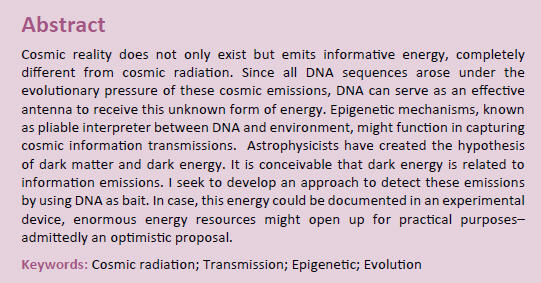

- Recommended reading
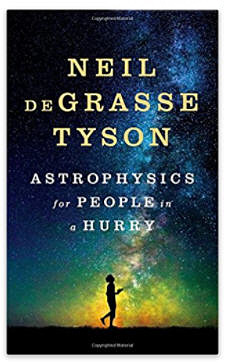 |
 |
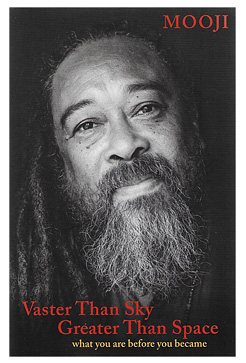 |
| Here
are three books well worth exploring, as you wonder about our place in
the universe |
- Bruno Putzeys - of Hypex amps
and Kii-3 loudspeaker fame - wrote about MQA on facebook:
| This isn't a prelude to
suddenly becoming active on FB but I felt I had to share this.
Yesterday there was an AES session on
mastering for high resolution (whatever that is) whose highlight was a
talk about the state of the loudness war, why we're still fighting it
and what the final arrival of on-by-default loudness normalisation on
streaming services means for mastering. It also contained a
two-pronged campaign piece for MQA. During it, every classical
misconception and canard about digital audio was trotted out in an
amazingly short time. Interaural timing resolution, check. Pictures
showing staircase waveforms, check. That old chestnut about the ear
beating the Fourier uncertainty (the acoustical equivalent of saying
that human observers are able to beat Heisenberg's uncertainty
principle), right there.
At the end of the talk I got up to ask
a scathing question and spectacularly fumbled my attack*. So for those
who were wondering what I was on about, here goes. A filtering
operation is a convolution of two waveforms. One is the impulse
response of the filter (aka the "kernel"), the other is the
signal.
A word that high res proponents of any
stripe love is "blurring". The convolution point of view
shows that as the "kernel" blurs the signal, so the signal
blurs the kernel. As Stuart's spectral plots showed, an audio signal
is a much smoother waveform than the kernel so in reality guess who's
really blurring whom. And if there's no spectral energy left above the
noise floor at the frequency where the filter has ring tails, the ring
tails are below the noise floor too.
A second question, which I didn't even
get to ask, was about the impulse response of MQA's decimation and
upsampling chain as it is shown in the slide presentation. MQA's take
on those filters famously allows for aliasing, so how does one even
define "the" impulse response of that signal chain when its
actual shape depends on when exactly it happens relative to the
sampling clock (it's not time invariant). I mentioned this to my
friend Bob Katz who countered "but what if there isn't any
aliasing" (meaning what if no signal is present in the region
that folds down). Well yes, that's the saving grace. The signal
filters the kernel rather than vice versa and the shape of the
transition band doesn't matter if it is in a region where there is no
signal.
These folk are trying to have their
cake and eat it. Either aliasing doesn't matter because there is no
signal in the transition band and then the precise shape of the
transition band doesn't matter either (ie the ring tails have no
conceivable manifestation) or the absence of ring tails is critical
because there is signal in that region and then the aliasing will
result in audible components that fly in the face of MQA's
transparency claims.
Doesn't that just sound like the
arguments DSD folks used to make? The requirement for 100kHz bandwidth
was made based on the assumption that content above 20k had an audible
impact whereas the supersonic noise was excused on the grounds that it
wasn't audible. What gives?
Meanwhile I'm happy to do speakers. You
wouldn't believe how much impact speakers have on replay fidelity.
________
* Oh hang on, actually I started by asking if besides speculations
about neuroscience and physics they had actual controlled listening
trials to back their story up. Bob Stuart replied that all listening
tests so far were working experiences with engineers in their studios
but that no scientific listening tests have been done so far. That
doesn't surprise any of us cynics but it is an astonishing admission
from the man himself. Mhm, I can just see the headlines. "No
Scientific Tests Were Done, Says MQA Founder". |
________
My thoughts: Human hearing is a non-linear process of sound perception as
can be deduced, for example, from the equal loudness contours. Hearing
evolved for survival. High frequency ticks and clicks are instrumental in
determining the direction to the location of a potentially threatening
source. I wonder if we have hearing acuity for such type of signals that
goes beyond the frequency range for steady-state stimulus perception. I
doubt that hearing can be fully described in Fourier analyzer terms. If Bob
Stuart truly has discovered a new perceptual phenomenon, then he needs to
demonstrate it scientifically. Otherwise MQA is just a marketing ploy to
resell previously recorded material in a proprietary file format and they
are Phishing
for Phools. - SL
-
- Artificial
Accuracy
The Metrology of Quality, Quantity and Convenience
Story and Context
- A story of purpose
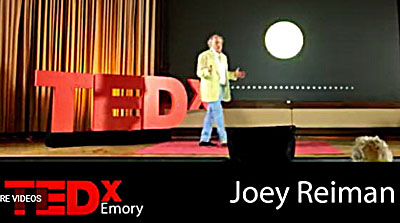 |
Mark Twain:
The two most important days of our lives ...
1 - The day we were born
2 - The day we found out why |
-
 |
Hi Siegfried,
I thought you may be interested in this brief
TED Talk if you have not already seen it.
It describes an experiment looking at what happens in the brain when a
subject is tasked with focusing on one of two visual elements (overt
attention) compared to when tasked to focus between them (covert
attention).
I would suspect this would have strong parallels
with audio stream segregation.
Regards,
James Heddle
Acoustical Consultant |
-
 |
Neuroscientist Uri
Hasson researches the basis of human communication, and experiments
from his lab reveal that even across different languages, our brains
show similar activity, or become "aligned," when we hear the
same idea or story. This amazing neural mechanism allows us to
transmit brain patterns, sharing memories and knowledge.
"We can communicate because we have a
common code that presents meaning," Hasson says.
|
-
What is so special about vinyl?
| My dear friend, Craig Allison,
founder, singer and slide guitar player of a local 'Bourgeois Blues
Band', and now selling 2-channel sound at Lavish
Hi-Fi in Santa Rosa, wrote to me:
Hi Siegfried,
We had a big vinyl event here last Saturday;
absolutely amazing, almost 200 people, about 1/3 of the doctors in
Santa Rosa were here.
We put on a great show, but I remained
quizzical as to the outrageous major buzz that manifested unlike any
other event we've had. I have preciously dwelt on this 'phenomenon' at
some length, and concluded that the distortion family of vinyl is
being re-embraced as an antithesis to the sound of highly compressed
MP-3.
Remember, you don't listen to a lot of
terrible current pop music, but the masses do.
But the reaction I picked up obviously went well past this one factor.
Had a great Facetime chat w/ a brilliant
friend of mine in Canada last night, talked about this.
And then it hit me: the significance of ritual, and what happens when
you take it away.
The public is overjoyed returning to a ritualized recorded music
playback.
As I enjoy certain rituals as well, I
understand that the same experience w/o ritual is simply not the same
experience at all. I love CD, but there is no palpable ritual
involved, and even less using a phone to bluetooth etc. ....
Yes, Craig, your thoughts resonate strongly with
me.
We all know that music can touch and move us at a deep level. And
going through the preparations for playing a vinyl disc, then sitting
down in anticipation, is like opening a perceptual door, paying
attention, being ready to receive and to lose one's daily self.
Streaming a concert by the Berliner
Philharmoniker can have such an effect on me.
I just started reading: 'Music, The Brain And
Ecstasy - How Music Captures Our Imagination' by Robert Jourdain.
Fascinating! |
-
Dynamic Range: No Quiet = No
Loud
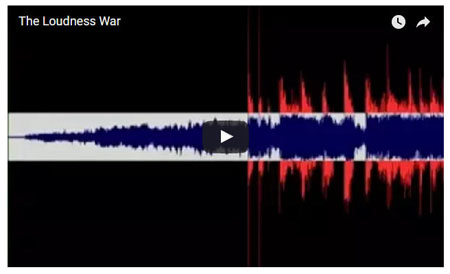
-
Music with a Cochlear Implant?
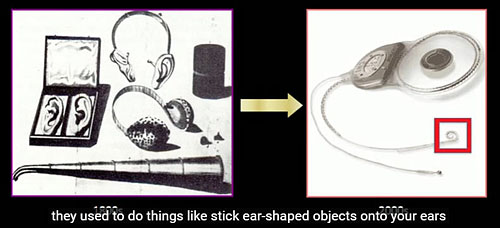
-
Archimago's Musings

-
AmericanRadioHistory.com

My "Loudspeaker
System Design" articles were originally published in Wireless
World, 1978, May,
June,
December.
-
Technology Trends - High Resolution
Audio
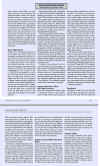 JAES, March, 2017
JAES, March, 2017
-
The
Art of Listening - from the artist's and producer's perspective
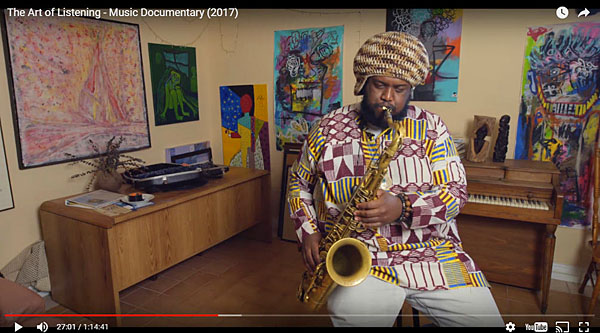
Chesky
Records
-
Room
Acoustics for Listening - James Heddle, Acoustical Consultants,
Brisbane, Australia -
facebook
".... Acoustic design targets based on data and parameters derived from
single microphone measurements are therefore likely to have inadequacies and
may be misleading. Overall this implies our current understanding and models
of perceptual processes, including those involved with listening, have
significant room for improvement and are likely to more fully develop over
time. We should, therefore, be cautious of design based solely on room
acoustic parameters given in current international standards (Lokki,
2013)."
-
Fresnel
Zones and Spheroids for Room Acoustics - - James Heddle, Acoustical
Consultants, Brisbane, Australia -
facebook
Abstract - The concept of Fresnel Zones arises from considering reflection
paths off a surface differing from the direct sound propagation path by some
multiple of half a wavelength. The modelling of these zones, and of zones
derived using a set time delay, provides useful insights for the design of
spaces for listening and communication. This paper gives an overview of
analysis using this approach together with some examples and is intended as
a companion paper to 'Room Acoustics for Listening'.
-
Loudspeaker Cabinet Diffraction
The paper
by Tore Skogberg illustrates the difficulties in analyzing and
predicting diffraction effects. Added to that are the finite dimensions and
modal breakup effects of real sources. But it is important to understand the
general trends in order to design sensible baffle shapes and to optimize
them by acoustic free-space measurements on-axis and around the
cabinet. See also My
Conversations with Fitz.

-
A Meta-Analysis of High Resolution Audio - Perceptual
Evaluation
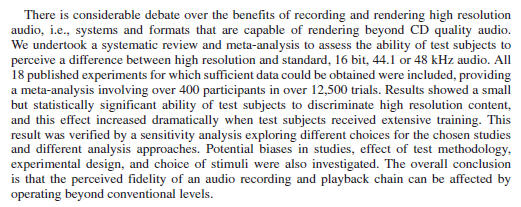
-
ECMA-407 and Telecommunications
in the 21st Century
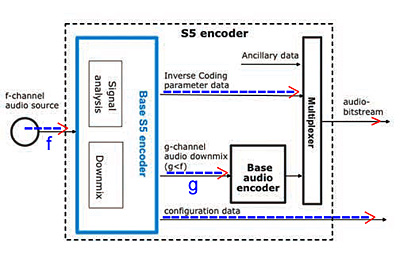
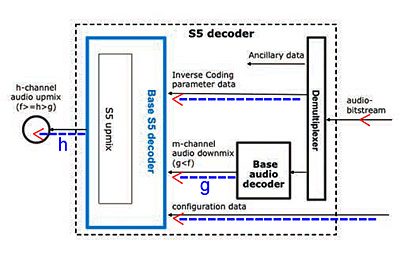
|
InterComms talked
to Ecma TC32-TG22's Convenor and Swissaudec's CEO Clemens Par about
the 21st century's broadcasting and communication means.
The pdf of
the interview gives an introduction to the ingenious concept and
methodology behind the Ecma-407 standard for down-mixing f-channels of
audio into g-channels and then transmitting them using currently
deployed codec's like AAC or HE-AAC. On the receiving end of the
bit-stream transmission the g-channels can be up-mixed again to
f-channels or a smaller number of h-channels depending upon the
playback setup.
The process has higher proven performance than
UHD 3D-audio codec's currently under development. See the White Paper:
ECMA-407
"Instant HD to UHD Audio".
Clemens Par gives credit to Rudolf E. Kalman and
Guenther Theile in the InterComms publication of: Rationalism
versus Empirism - A Crash Course in Invariant Theory.
Swissaudec exhibited in 'NAB Labs Future Park'
at the 2016 NAB Show
in Las Vegas.
Disclaimer:
I am a personal friend of Clemens Par, having met him first at TMT26
in 2010, where I was mightily impressed by his process for up-mixing a
mono audio signal to stereo as if recorded with a MS coincident
microphone pair. Since then much more powerful applications have
evolved out of Invariant Theory and inverse coding. But it pains me to
see how established audio standard setters resist to accept and
incorporate the new paradigm.
See also Rationalism
and swissaudec GmbH below. |
-
Reverberation ...and how
to remove it
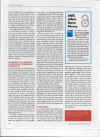 |
The Feature Article by
Francis Rumsey in the April 2016 issue of the Journal
of the Audio Engineering Society ends with a section about THE
BENEFITS OF BINAURAL LISTENING IN REVERBERANT CONDITIONS (copy on
left).
Auditory stream segregation is at play when the
listening room and the loudspeakers in a
proper stereo setup recede from perception and are moved beyond
the acoustic horizon of the listener. |
-
Floyd Toole: Room
reflections and Human Adaptation for Small Room Acoustics
Floyd's article in www.audioholics.com
discusses hearing in reflective, resonant and reverberant spaces. I find it
refreshing to read:
"Humans evolved while listening in reflective spaces,
and are comfortable listening in them. In fact, it is now widely recognized
that we perceptually
"stream" the sound of the room as separate from the sound of the
sources - that is what happens in live performances. A Steinway is a
Steinway; only the hall changes. Performance halls generally don’t have
room mode problems because they are so large. The parallel situation in
sound reproduction is that a good loudspeaker is a good loudspeaker, and its
virtues are appreciated in a wide variety of rooms – except for the
differences in the bass region."
(The differences in the bass region largely
disappear when dipolar or cardioid woofers are used. - SL)
"As an illustration of how much loudspeaker technology has improved
over the years, these data on the JBL Pro M2 indicate that whatever one’s
opinions of loudspeaker/room interactions were in the era of the UREI, they
cannot be the same in the era of the M2, and any similarly “neutral”
loudspeaker. Because it is desirable
that the direct and reflected sounds resemble each other, the newer
loudspeaker has an enormous advantage. Traditions need to be put into
context, and some of them relegated to history."
("Neutral" ultimately means Constant Directivity over 4p
space. The M2 represents a step in the right direction, but is still
omni-directional at low frequencies and forward directional, though with
wide dispersion, at high frequencies. - SL)
I just wish more speaker designers would take seriously the
implications of the highlighted statements above.
See also a more recent article by Floyd "What
do listeners prefer for small room acoustics?"
-
Floyd Toole: The
Measurement and Calibration of Sound Reproducing Systems
In his Paper
you find out about traditions and the disappointing state of affairs in
professional audio. A discussion of this Open Access AES Paper is at
the AES
Journal Forum
-
Seth Horowitz: The Universal
Sense - How Hearing Shapes The Mind
Here is an easy to read book,
written by a neuro-scientist for the general public, which describes the
response of the ear/brain perceptual apparatus to sound, to what draws our
attention, affects our emotions, our memory and possibly our actions. I
highly recommend this book to anyone involved with sound, whether in
production, rendering or listening. My loudspeaker designs for creating
convincing auditory illusions in ordinary rooms are intentionally based on
evolutionary hearing processes as described by Horowitz.
-
Optimizing the directivity
index of a 2-way loudspeaker
Diego Ivars Morón's Master's
Thesis at the Norwegian University of Science and Technology deals with
different approaches to obtain very wide dispersion from the tweeter section
of an otherwise omni-directional loudspeaker.
-
Acoustic power radiation from loudspeaker cabinets
Conventional box loudspeakers very often suffer from spurious sound
radiation, which is caused by the mechanical vibration energy of the drivers
being transmitted into the cabinet and exciting the cabinet walls to vibrate
at certain panel resonance modes. Furthermore, the high sound pressure
levels inside the cabinet can excite panel modes. Since the cabinet's
radiating surface areas are usually much larger than the driver cone area
even relatively small panel excursions can lead to significant
spurious acoustic output. Depending upon the cabinet construction the output
might even be larger at certain frequencies than the desired output from the
driver. In addition, air borne acoustic energy inside the cabinet, which is
very difficult to absorb and to turn into heat will escape via the thin cone
material of the driver and can color the sound. These problems taken
together and combined with a sub-optimum radiation pattern generates the
generic box loudspeaker sound. Conversely, an acoustically small,
open-baffle (dipole) loudspeaker with its minimal baffle area and no box
enclosure is largely free of spurious emission problems.
The Open Access AES paper "Predicting
the Acoustic Power Radiation from Loudspeaker Cabinets: a Numerically
Efficient Approach" deals with acoustic radiation due to structure
borne vibration energy in a highly braced cabinet. It is an interesting read
and shows how much attention must be given to cabinet details to minimize
spurious emissions.
-
Hauptmikrofon.de
The Hauptmikrofon.de
website was updated by Helmut Wittek (Schoeps)
and relaunched in 2015 with an emphasis now on 3D audio. Unlike WFS or
Ambisonic approaches that aim for exact physical reconstruction of the
recorded soundfield here are microphone arrangements described, which
exploit the psychoacoustics of hearing and Gestalt recognition as originally
described in the groundbreaking work by Guenther Theile. While the emphasis
is on microphones and their characteristics
on the sound recording side, little is said about loudspeakers and rooms,
which after all are the other half of the story on the sound rendering side.
As far as I know conventional box loudspeakers have been used to assess the
recording techniques. This can only be justified by their popularity. But if
optimum 3D rendering is the goal then also loudspeakers, their
characteristics and setup, and the room have to be revisited!
3D
Audio Natural Recording -
Microphone
Techniques for 2.0 and 5.1 Ambience Recordings -
ORTF-3D Microphone technique for 3D ambience recording -
-
Rationalism versus Empirism
This publication by Clemens Par
of swissaudec
in Issue 25 of InterComms
is a tribute to Professor Rudolf Kalman and was inspired by conversations
between them. It is also a tribute to Guenther Theile's groundbreaking work
in auditory spatial perception. Their mathematical contributions to systems
and invariant theory combined with new understanding of cerebral spatial
hearing processes have led to new forms of audio coding as now standardized
in ECMA-407 for UHD 3D audio.
I am pleased to know that Clemens considered the PLUTO's design and phantom
imaging, which he heard at TMT26 in 2010, as proof for his then new,
invariant method of upmixing from mono to stereo. See also below:
swissaudec
swissaudec GmbH
Ecma publishes the world's first 3Daudio standard:
ECMA-407
-
Music Theory & MIDI Encoding
In this YouTube
video Charlie Gillingham (2015 NuPIC Hackathon) talks about the
challenges in machine decoding MIDI files, whereas the human brain's Hierarchical Temporal Memory
(HTM) has few difficulties
with audio stream segregation. See also the talk about Machine Intelligence
below.
Stream analysis and segregation is a fundamental process of the brain. For
example, when listening to a pair of loudspeakers segregation between direct
streams and room reverberated streams is made easy or difficult by the
loudspeaker setup and their radiation pattern and leads to the creation of
different phantom scenes in the listener's brain.
-
Machine Intelligence as
derived from biological processes
Jeff Hawkins of Numenta
gives a fascinating talk about pattern recognition in the brain. I take from
it that the change in sensory input data streams with movement (temporal),
for instance with eye movement in vision and head movement in hearing (=
changing HRTF), is fundamentally tied to how we process perception of the
world around us.
"Principles of
Hierarchical Temporal Memory (HTM): Foundations of Machine
Intelligence"
https://www.youtube.com/watch?v=6ufPpZDmPKA
-
Nelson Pass talks about power
amplifiers
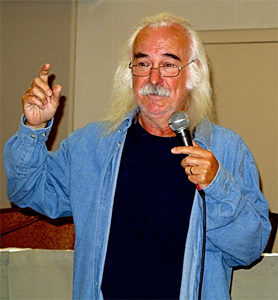 |
At the 2015
California Audio Show Nelson Pass talked about power amplifiers
and how he sees his role of being in the Audio Entertainment Business,
i.e. where different design approaches satisfy different customer's
tastes and demands. He has been eminently successful with his
products, which are knowingly designed to sound good, to last forever,
with rare model changes, and which are readily serviced in the
unlikely event that they ever need it.
Nelson ran out of time for his talk. What he
covered is written up at firstwatt
almost verbatim. See also the stereophile
CAS6 summary of his talk. |
-
"24/192 Music
Downloads ....and why they make no sense"
A highly educational article from www.xiph.org
See also from CNET:
"Sound bite: Despite Pono's promise, experts pan HD
audio"
and somewhat related but in German:
"Kreuzverhörtest: Der c't-Leser-Hörtest: MP3
gegen CD"
-
Peter Aczel - "The Audio
Critic" - What I have learned after six decades in audio (call it my
journalistic legacy) - 30 April 2015
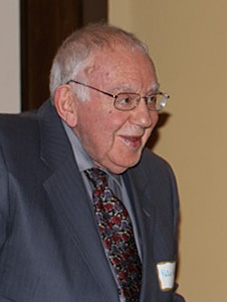 |
A month before his 89th birthday
Peter Aczel published his Audio
Legacy ending a long obsession with no nonsense and trustworthy
audio journalism.
"The Audio Critic" publication, which
had turned into a Web 'Zine after Issue No. 29 in 2003 has now been
archived by www.biline.ca
and is no longer being updated
My contacts with TAC began when I responded to
Floyd Toole's article in No.
28 with a letter
to the editor, which was published in No.
29 and to which Peter Aczel responded with a challenge to send him
one of my open-baffle designs to test my claims. Don Naples of Wood
Artistry build a pair of ORION speakers for him. Don Barringer helped
to set them up and tweaked them to his "Subjective
Neutrality" version in later years. Still, Peter could not resist
to also eventually own the LX521
built by Dr. Frank
Brenner, thus following the progress that has been made since his
initial challenge to me.
Congratulations, Dear Peter, on your 89th!
I wish you many more years of acceptable health, companionship with
your wife and joyful listening to come!
A well deserved trust in your reviews and
opinions has convinced many to build ORION, PLUTO or LX521 speakers.
Thank you. |
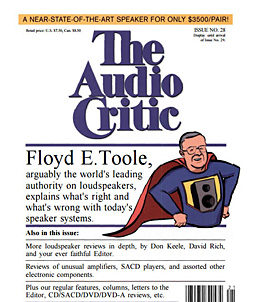 |
-
Floyd Toole - Sound reproduction
– art and science/opinions and facts
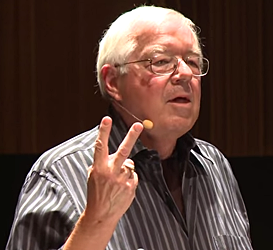 |
Floyd Toole, retired
from heading R&D of the Harman Group, continues to educate about
loudspeakers in rooms. Here is a recent lecture at CIRMMT on YouTube.
As always he gives a lucent presentation, arguing for a flat on-axis
frequency response, non-resonant behavior and a smoothly controlled
directivity index, e.g. JBL
M2.
According to my observations/conclusions he does
not go far enough towards constant directivity and only talks about
box speakers, which always start out as omnis at low frequencies and
have associated room resonance issues.
See also Francis Rumsey's talk about Spatial
Audio below. |
-
Do you know your PSA? --- Singing
the Prostate Cancer Blues
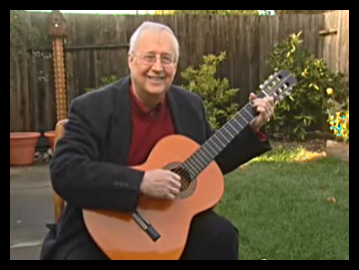 |
Each year in the USA
about 239,000 men are diagnosed with Prostate Cancer, and 30,000 men
die from it. Lifetime risk is 1 in 6. www.ustoo.org
In its early stages Prostate Cancer usually has
no symptoms. PSA
testing is the best way to find Prostate Cancer early. This may help
save your life. A simple blood test can determine your PSA
(prostate specific antigen).
Doctors recommend that your PSA be determined beginning at age 40 (35
if you have a family history of Prostate Cancer or are African
American). Retest regularly based on your doctor's recommendation.
Get a PSA Test
The PSA Test is as important to men as the Mammogram is to women. |
-
DIY Power amplifiers with
extremely low distortion
On his Neurochrome
Audio website Tom Christiansen describes and offers solid-state and
vacuum tube power amplifier designs, circuit boards and construction plans
for DIY. Power levels are well suited to my LX series speaker designs.
Specifications are excellent but I have no listening experience with such
low levels of distortion. My requirements usually stop when harmonic
distortion is <0.01%, damping factor >20 and associated power supplies
are able to deliver adequate voltage or current peaks for high level
transients. Most importantly, the amplifier must not go into spurious
oscillation, or DC output generation, or other misbehavior when internally
voltage or current clipping. My active crossover, multi-channel loudspeakers
put much less demand on the individual amplifiers, than the typical n-way
passive crossover speakers that are common place, because each amplifier
sees a benign load made up of the speaker cable, the voice coil impedance
and the motional back emf.
But still, it would be rewarding to find out that even more realism can be
gained from the LX's when Neurochrome amps are used.
-
Mono to Stereo Upmixing - Website
Christopher Kissel writes to me:
"....Listen to the examples on the MEDIA page of my website as well as
the samples that are available on the three compact discs that are linked to
on the NEWS page of my website. My interest is in stereo upmixes which
include distinct, stable separation of vocal and instrumental elements from
the original mono source, i.e. stereo mixes that sound like they were
created from multi-track session tapes, had they existed...."
"....The attached file represents what I expect when I refer to a mono
source upmixed to stereo. The mp3 is of the 1956 mono recording of ‘The
Poor People of Paris’ by Les Baxter & His Orchestra upmixed to stereo
through the use of audio spectral editing. While I realize that there is a
big difference between real-time upmixing from mono to stereo, as with the
Voicode plug-in (www.swissaudec.com),
and the amount of time and effort to upmix a mono song to stereo through the
use of spectral editing, I think that you’ll agree that the attached mp3
is quite spectacular!" (The
Poor People of Paris.mp3)
He states: "Mono is a form of
distortion". I agree. It is spatial distortion, which his upmix
to pan-pot stereo removes to a high degree. To me pan-pot or multi-track
mixes are still distortions of the spatial context in which natural sounds
always exist. Furthermore, listening to the examples I have the impression
that new, unpleasant timbre distortions have been introduced. Without
hearing the original mono version I cannot tell which form of distortion I
would prefer to live with in order to enjoy the musical content of the old
mono recordings. But the technology presented here is certainly a big step
up from earlier attempts to add spaciousness to mono recordings.
-
The
High Resolution Audibility Test - Oliver Masciarotte
He points to the limitations of listening tests,
including ABX tests. The problem is plasticity of the brain. Perception
depends upon brain processes, which are not stable with time. Personally, I
rely on listening over time, not quick A/B comparisons, which require close
attention. The attentive part of the brain tires readily and falls for
(auto)-suggestions. The subconscious part of the brain is always active in
survival mode. In long-term listening it tends to brings up to my attention
what it hears as unnatural. But only if it is regularly refreshed with
natural sounds. I find myself in agreement with Masciarotte's observations.
-
Ken C. Pohlmann - Principles of
Digital Audio - McGraw-Hill, 2011, 6th edition
A very comprehensive and readable guide to everything digital in audio
recording, processing, storage, transmission and playback.
-
J. Blauert (Ed.) - Communication
Acoustics - Springer, 2005, 2010
Sixteen authors contributed to this collection of review articles
covering some of the most relevant areas of communication acoustics. Much is
about scientific understanding of how we hear and how to model it for
further study. I am fascinated by implications to the design of loudspeakers
for rendering a convincing auditory scene in acoustically small reverberant
spaces.
For example a few lines from chapter 1: Analysis and Synthesis of Auditory
Scenes:
"As we all know, the behavior of human beings is not guided directly by
the acoustical signals that we provide them with, e.g., like a reflex, but
rather by the "meaning", which is transferred via those signals.
Consequently, an important demand of advanced communication technologies is
to gain information on how human beings interpret acoustic signals on the
background of their individual situational and background knowledge, i.e.
what the signals actually mean to them."
And about "Cocktail-Party Processing":
"The term cocktail-party effect denotes the fact that human listeners
with healthy binaural hearing capabilities are able to concentrate on one
talker in a crowd of concurrent talkers and discriminate the speech of this
talker from the rest. Also, binaural hearing is able to suppress noise,
reverberance and sound coloration to a certain extent."
-
Experts ask the Experts
about Sound Recording and Sound Reproduction
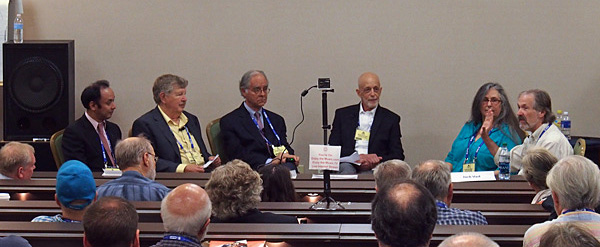 |
To me one of the most
significant events at the Rocky Mountain Audio Fest 2014 was the "Experts
ask the Experts" exchange of viewpoints regarding sound recording and sound
reproduction.
The discussion was honest and enlightening to both experts and
audience. The explanations could help audiophiles to understand some
of the limitations involved in recording and reproduction, and to
appreciate the work done and to make educated choices.
|
| View
the discussion on YouTube. In addition to my observations about
externalizing headphone reproduction, I want to emphasize that it is the
change of the HRTF with head movement that strongly helps to
externalize and not just the stationary HRTF by itself. (Note that all
our senses - seeing, hearing, touching, tasting, smelling - are
primarily change detectors.) Furthermore, externalization can be
learned and retained at least for a while. Thus I can envision turning
a smart-phone in combination with head turning and changing the ear
signals as a brain training procedure for 3D listening to stationary
HRTF encoded program material. Someone ought to try this. The 3D
rendering over headphones (without head tracking) that I have heard so
far produces far too much distance foreshortening to sound spatially
realistic. |
-
SOUND BOX with Meyer Sound
Constellation Acoustic System
Last night I attended a variety of performances under the title EXTREMITIES
in San Francisco Symphony's new SOUND
BOX. It was an exciting event. Of particular interest to me was the
installed Meyer Sound Constellation
Acoustic System, which I had never heard before. It performed
exceedingly well in giving the venue different acoustics, appropriate to the
style of music being played by the musicians or sounds being rendered. But
unlike other spatial sound enhancement systems, which pick up the musician's
sound with nearby microphones and then convolve the signals with the impulse
response of some other venue, delay them and play them back over multiple
distributed loudspeakers in the hall as reverberated sound, the
Constellation system works with the hall itself. There are no microphones
dedicated to the musicians, but there is an overhead matrix of widely spaced
microphones covering the whole venue. There is a widely spaced ring of
loudspeakers up and along the walls and also loudspeakers overhead. I think
individual microphones feed nearby loudspeakers in such a way as to avoid
acoustic feedback and in such a strength as is desired for the musical
performance. Thus the venue can be changed from being quite dead to church
like acoustic proportions and also be different from one end of the hall to
the other. For example a group of singers walking in from one end of the
hall can first sound quite distant and then become gradually nearer sounding
as they approach the stage. The significant feature of the Constellation
System is that each microphones picks up the direct sound at its location
generated by the performers and the diffuse sound in the hall. This mix is
processed and played back over adjacent loudspeakers at a desirable level.
The musicians are free to move as in a natural acoustic environment.
Ensemble play seems to be working fine. Not everything was perfect, though.
The violins in a small ensemble playing Ravel were barely audible from my
close seat while the harp was overpowering. I suspect the acoustically open
and dead space behind the group of musicians, which was hidden behind a huge
projection was to blame for a lack of primary reflections. Violins on a
different stage in the Monteverdi piece sounded strong. I am sure more fine
tuning will happen to this remarkable SOUND BOX.
WIZARDS
OF SOUND - Retouching acoustics, from the restaurant to the concert hall
THE NEW YORKER writes about the Meyer Sound Constellation Acoustic System
and the SFS SOUND BOX.
For a different approach to changing hall acoustics see "Recording
in a virtual acoustic space"
-
Spatial Audio -
Reconstructing Reality or Creating Illusion?
At the May 21, 1994, meeting of the Chicago AES Section Francis
Rumsey
gave a presentation entitled, “Spatial Audio - Reconstructing Reality or
Creating Illusion?” Francis
Rumsey is an independent technical writer, editor of the JAES and
consultant based in the UK. After Bob
Schulein introduced him as “knowing a lot about a lot of things,”
Francis began his presentation by indicating that for over 100 years, a
battlefield has existed between those that want sound to be an accurate
reconstruction and those that want it to simply sound nice. Only 5% of the
recordings sold in the commercial market are actually made in a “natural
space”; 95% percent are “manufactured” in the studio.
Francis Rumsey’s presentation is now posted
on YouTube .
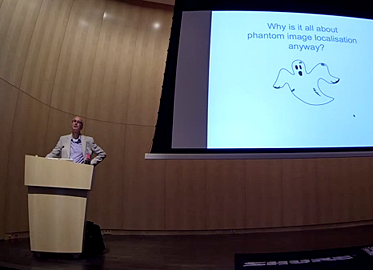
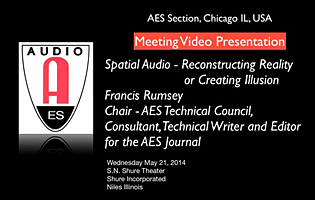 |
I find myself in full agreement with Rumsey's
presentation of spatial perception, but miss a discussion of the perceived
distances of phantom sources. Distance is a separate perception from
direction and evolutionarily speaking as important as direction. In the case
of 2-channel stereo we naturally localize each speaker in its environment by
head movement and HRTF changes and from it the ear-brain apparatus
receives cues about the distance to the speakers and thereby about a minimum
distance to any perceived phantom sources. Such phantom sources even stay in
their locations with head movement. We draw perceptual cues about greater
distances from the program material and its recorded venue reverberation,
and from playback volume. In order to clearly localize and then to
perceptually withdraw attention from speakers and room, the reflections from
the speakers must be delayed and diffused, and be similar in timbre to the
direct sound.
If the speakers are highly directional, like large horns, and the room is
acoustically dead, then a phantom center voice can be perceived in front of
the plane between the speakers. In that case we are approaching earphone
listening, for which the phantom source is localized inside the listener's
head. With earphones, and without head tracking, it is probably impossible
to perceive frontal phantom sources at realistic distances outside of the
head. Whispering into the ears works really well with earphones, but not at
all with loudspeakers. Distance issues show up similarly with WFS, 22.2 or
Atmos surround systems, where the loudspeakers define the plausible distance
of the acoustic event from the listener, who seemingly sits in an
acoustically empty ring or tent formed by the speakers.
In this context it is also of interest to read 10. SOCIAL PERCEPTION OF 3D AUDIO
from AES 137th Convention
Paper #9218 titled: "ECMA-407: New Approaches to 3D Audio Content
Data Rate Reduction with RVC-CAL".
-
https://www.freedsp.cc/
The freeDSP is a low-budget open-source audio-dsp (digital signal processor)
module for the do-it-yourself community. The applications range from active
loudspeaker concepts (digital crossovers, bass enhancement, ...) and room
equalization over steerable microphone arrays to advanced effect
processors.
It's open-source: The freeDSP board is published under a creative commons
license (CC-BY-SA). It allows the unrestricted use and modification of the
module.
Easy programmability with SigmaStudio. No advanced coding skills are
necessary. The freeDSP works with a free graphical development environment.
The programming model is function-block based. Just drag-and-drop some
processing blocks and virtual cables - and you are ready to go!
-
A call for an open source
loudspeaker project
Ruediger Franz Rauskolb, a
former colleague at HP and longtime friend, sent me "My
Life's Journey through Audioland", in which he says: True to the
spirit of “copy left” I would like to propose the opening of an open
source project. The outcome would be a design that is available to anyone
free of charge, or based on donations. There would be no proprietary
component in this. Rather than competing with each other, in order to get
the ego satisfaction of coming up with the worlds best design, I would like
to work as a group working together for a common goal, deriving not ego
satisfaction, but something possibly much more satisfying in the end, the
knowledge of having contributed to the common good. This may enable a
broader section of society being able to enjoy listening to pure music for
their own healing and benefit, rather than satisfying the upper 1% of
society, being able to afford ever-increasing prices for audio equipment.
-
Ecma publishes the world's first 3D audio
standard: ECMA-407
At this year's International Broadcasting Convention in Amsterdam, IBC
2014 - IBC Future Zone, the world’s first 3D audio standard will be
showcased by swissaudec
at Stand 8.F38. The ECMA-407 standard extends known audio codecs, to provide
an unrestricted 3D experience up to NHK 22.2 at bit rates of 256kb/s and
below - and simultaneously to mobile devices down to 48kb/s via a generic
VOICODE® "app" and state-of-the-art binauralization.
At the 137th AES
Convention in Los Angeles a technical paper will be presented in Session
P1-Spatial Audio:
P1-7 ECMA-407: New Approaches to 3D Audio Content Data Rate Reduction
with RVC-CAL.
The new "inverse coding" methodology will be highlighted.
See also VOICODE®
and the tmt
2012 paper: Two Undiscovered Treasures in Spatial Audio:
Inverse Problems and Invariant Theory. (Abstract)
Reprint: https://www.vdtshop.de/2012SA6
An update paper was presented at tmt
2014 with the title: ECMA-407: A New 3D audio codec
implementation up to NHK 22.2 with RVC-CAL. (Abstract)
-
THE DISTORTION OF SOUND
The Harman Group has produced a
movie in which musicians and audio producers lament the loss of quality
when their art is delivered in MP3 format, compressed and streamed. I think
compression is the primary problem and not lossy coding, if the data rate is greater
than 128 kbps. They also point to glossy headphones, earbuds and portable
devices as contributors to the sad state of sound reproduction. I suspect
that the master tapes are already compressed and distorted for minimum
dynamic range and maximum continuous loudness. I listen, and often with
great satisfaction, through my loudspeakers to streamed music from European broadcast stations and
others using the TuneIn Radio application and selecting the highest bit rate
offered (>128 kbps).
-
SOUND AND RECORDING -
Applications and Theory
Francis Rumsey and Tim McCormick have given us with the 7th
Edition an excellent reference for reading up on the art and science of
recording, as it is practiced in 2014 with analog and digital tools. The 655
page book is well
organized, clearly written and illustrated with easy to understand graphics.
-
We need to talk about SPEAKERS:
Design, DSPs and the debunking of traditional hi-fi
writes John Watkinson in the July 2014 issue of The
Register.
A timely, interesting, mostly to the point, but not conclusive article about
the state of the loudspeaker industry.
-
Reflecting on reflections
In the current issue of the Journal of the Audio Engineering Society (JAES
Volume 62, Issue 6, pp. 454-455; June 2014) Floyd Toole asks:
"Is it time to put Sabine in his place?".
To express my sentiments and to start the discussion in the Journal I
responded with:
It is about time that the audio industry and academia address the
loudspeaker and room compatibility issue for domestic size reverberant
spaces and recognize it as just one more problem area in the transmission
path from microphone membrane to eardrum. The brain takes over behind the
ear drums, creating the perception of an acoustic event in some form of 3D
space. The perceived scene is spatially distorted due to the directional
characteristics of microphones and their distances to sound sources, and due
to the directional characteristics of loudspeakers and their distance and
azimuth to the listener. The microphone output signals contain a limited and
specific view of the original acoustic scene. On playback the loudspeakers
illuminate the listening room. The resulting eardrum signals consist of
superimposed streams of air pressure variations arriving from different
directions. With two ears, a movable head, a brain and a mind, evolution has
formed a superbly capable perceptual apparatus, which automatically sorts a
plurality of sound streams for direction, distance, meaning and for focusing
attention. Loudspeakers and room (also the room behind the speaker membrane)
must not provide misleading cues to a listener's brain in order to fully
hear the information contained in the microphone signal streams and to
instinctively withdraw attention from loudspeakers and listening room. The
result is a convincing auditory illusion.
The job can be done. It has been done. A simple stereo system can render
in an ordinary room a more convincing 3D illusion than conventional
multi-channel surround setups, because it can put perception at ease.
Why has the audio industry not caught on other than trying to put patches
on the problem for decades?
-
Berliner Philharmoniker in
the Digital Concert Hall
I just discovered that my Oppo BDP-105 Blue-Ray Player lets me subscribe to
live and archived concerts of the Berliner Philharmoniker. Acoustical and
visual quality of the transmissions is excellent and fully matches the
musical performances. If you love symphonic music or want an introduction to
it, I cannot think of a better avenue. Concerts sound wonderful over the LX521
or the LXmini.
Check it out: https://www.digitalconcerthall.com/
-
Line array dipole for a
Concert Hall sound system
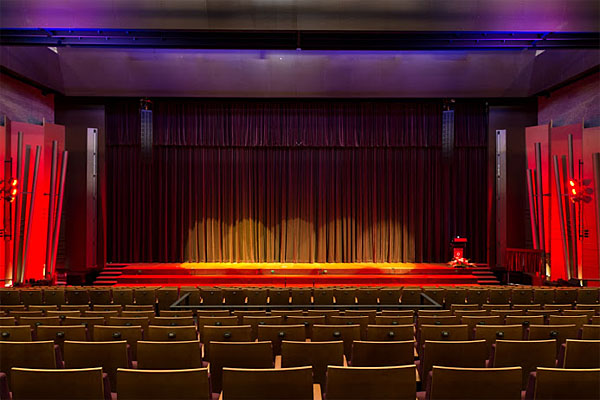 |
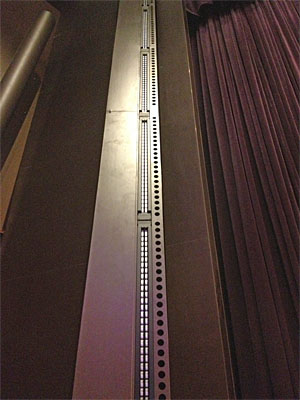 |
Dear Siegfried,
You may be interested to know that I have designed a line array dipole for a
Concert Hall sound system and this has now been completed. The system
consists of 6 x 1m high Radia Pro 1.0 elements per side with a 5 x Seas bass
drivers in dipole cabinet handling frequencies below 150 Hz. In addition to
this are two dipole satellite bass cabinets, one under the main floor and
one under the balcony seating to augment bass at these locations (the
columns are effectively a line source whereas the bass falls as per a
spherical source). The seating is flown/open which allows this. Filtering
and crossover tasks were handled by 6 x Hypex DLCP units and 6 x Joe Malone
Audio multichannel amps. The bass cabinets are directly under the stage
below the column array. the holes you can see in the column housing were to
move the first dipole null as high as possible. The satellite bass cabinets
have been delayed so that even though you can feel (yes feel) their effect
you still locate the stereo image frontally to the stage (55msec delay to
the stall underseat, bass and 95 msec delay to the balcony underseat bass).
A test concert was held last Sunday and
while there is room for improvement the system is performing well. Two
things were notable:
Very even response with minimal changes between positions in the audience
areas, stalls and balcony (you can also stand very close to the system
without it being excessively loud). The null of the system points diagonally
across the stage.
Stage located source and image - one of the goals of the design was to have
an soundstage at or near the actual stage.
Locating the system on the stage and having very consistent horizontal
directivity allows the early reflections to be similar to the stage acoustic
sources and this also is important for making the system less obvious.
To test the transparency of the system
during the orchestra performance I fed a bridge pickup from a double bass
into it and panned it to approximately the same location as the double bass
was on stage - no one I asked was aware that there was any involvement of
the sound system in the performance. This was exactly my intention, subtle
reinforcement of acoustic performances if they need some help.
One aspect that was 'discovered' when I
was eq'ing the columns was that they do not revert to dipole behaviour as
readily as I was expecting - you are still effectively very nearfield even a
couple of metres back - this made the determination of the dipole correction
less straightforward than I was expecting as once further into the Hall the
room reflections then started to cloud the measurements.
Also interesting was the difference in spatial quality between tapering the
columns in level and not (for the taper I used, from the bottom column,
-6dB, -1.4dB, 0dB, -1.4dB, -6dB, -15.6dB). The tapering notably improved the
sense of space in recordings or it may be that the image is just unnaturally
big without the tapering.
Its a little bit difficult to photograph the array and it is also fairly
innocuous, something I wanted. The
photo shows how in-situ the array is tilted back (to approximately match the
audience slope) with a toe-in of 24 degrees so that each column covers the
entire seating area. This also directs the null towards the middle of the
stage. The holes in the 'baffle' were used to shift the first dipole
response notch to as high a frequency as possible and also to blur the
distance to this edge.
Lots of fun and it does sound pretty
respectable! Played some Bucky Pizzarelli in your honour.
James
Heddle
Principal / Managing Director
James Heddle Pty Ltd
Acoustical Consultants
facebook |
a
Unit 34, 11 Manning Street, SOUTH BRISBANE, QLD, Australia 4101
e jheddle@jhacousticdesign.com
p 3844 1020
m 0411 220 764 |
( My first dipole design was a Public
Address column loudspeaker ) NEW November
2024: James Heddles excellent paper on how to amplify a life concert
with utmost fidelity: See
Towards a Better Integration of Room Acoustic and
Sound System Design for Multipurpose Venues.pdf
-
Agilent Fundamentals of Arbitrary Waveform
Generation, A High Performance AWG Primer
This Application Note from Agilent contains the most complete descriptions
and illustrations of DAC performance issues and of the reconstruction of
sampled signals into analog waveforms that I have seen. I highly recommend
to download
the free AN if you want to deepen your understanding of sampled waves,
DAC's and associated distortions and artifacts. What is audibly significant
is still another matter and often not obvious from graphics of electrical
performance presented to the eye, but can become a resource for marketing
claims.
-
HiFi Museum - Wiesbaden, Technik, Wissen und
Historie
A large collection of material about the development of High-End Audio from
1960 until today can be found on this German website.
Read my assessment of this development particularly as it
relates to loudspeakers.
-
SAVE THE STEREO
Few audiophiles or audio professionals have ever heard the degree to which
an optimally designed and set up two-channel system can create the illusion
and experience of an acoustic event. Usually the recording, the loudspeakers
and the room setup are to blame. Multi-channel surround sound is not the
solution, as that approach too often tries to overpower natural hearing
processes, rather than to cooperate with them. The potential of stereo in
the home has not been fully realized
and therefore should not be abandoned prematurely. SAVE THE STEREO
-
PAtH - Pure Audio to Health
A good friend of mine, Craig Allison, has started a website to raise
awareness of the health value of regular listening to good music.
https://www.path-pureaudiotohealth.org/
He writes about the effect in the January 2014 issue of Enjoy the Music.com
-
NUTSHELL HIGH FIDELITY
I just came across this
website while searching for 'Loudspeakers in the Sixties' and found
"The Art of Speaker Design" written by Lynn Olson.
He was and still is much involved in DIY audio. The website makes for
stimulating reading as Lynn digs deep into everything.
-
International Conference on Spatial
Audio - Fraunhofer IIS - DEGA - EAA - VDT - 2014
The website of the VDT carries the conference announcement.
The Call for Contributions also includes "Binaural
technologies". One would hope that not only earphone related topics are
discussed but also problems and solutions to rendering 2-channel recordings
over two loudspeakers in reverberant spaces. This subject matter deserves
new investigation, because its full potential has not been recognized. I see
the LX521 as a tool to demonstrate what
is possible in terms of spatial rendering and musical realism from two
loudspeakers in normal living spaces. Tonmeisters/recording engineers should
listen to the LX521 at home, in their living space, for enjoyment and also
for critique of what they accomplished with their monitors in the artificial
acoustic environment of their work station.
The VDT website now
provides access to all the conference papers.
By clicking <Tonmeistertagung>, <26th Tonmeistertagung 2010>,
<Congress>, <Fr, Nov 26th 2010 a.m.> and scrolling down to 'PE:
Perception & Esthetics' and then 11:30 - 12:00, you will find my paper
"Hearing Spatial Detail in Stereo Recordings". You could go on
this website to Publications #33 and find it
there.
-
Radiomuseum.org
See a 1923 "omni" loudspeaker by searching for Seibt TL11. It's
probably more like an upward facing cardioid. The first radio that I
successfully took apart and understood as to how it functioned was a Seibt DKE38 Volksempfaenger. This is a fascinating
website if you are interested in old equipment.
-
The Music Animation
Machine - "Music Worth Watching"
A graphical presentation of sound streams, which are superimposed at the ear drums
as sound pressure vibrations and which are deciphered in the brain as
belonging to individual sources. From temporal and spectral differences
between the ear signals for each stream and with head movement we localize
direction and distance to the origin of that stream in the presence of other
streams, reflections and reverberation. Surely an amazing accomplishment,
but necessary for survival.
Two Music Animation examples with James Boyk at
the piano:
Beethoven "Pathetique" Sonata, 3d mvmt. 4:24 < https://www.youtube.com/watch?v=pSABCXv1kQw
> In concert, 1984
Schubert "Erstarrung," from "Winterreise" 2:54 < https://www.youtube.com/watch?v=iBEEJsC1O5o
> In concert, 1985
-
Introduction to Sound
Recording
An easy to follow, yet technically solid text, which covers in short chapters
almost every subject that is related to sound recording. Written by
McGill University educated Geoff Martin, PhD, it can serve as a tutorial and reference for aspiring Tonmeisters and
professional or amateur recording engineers. A few chapters will still be
completed or added to this web-based publication in the future to keep it up-to-date. Your
donation for permission to download the PDF supports a worthy cause.
-
Bruno Putzeys on
Amplifiers and Class D
In Square CAD audio interview #15 Bruno Putzeys of Hypex Electronics
and Grimm Audio talks about his power amplifier designs and the undeserved
reputation of negative feedback. Stability of higher order and nested
feedback loops is often difficult to maintain and consequently they are
avoided by practically all amplifier designers. Easy to understand solutions
are preferred even when their performance is limited. In some ways this is
similar to loudspeaker design, where a flat on-axis frequency response and
sufficient output volume are the prime design objectives. (And room response
equalization with DSP will supposedly compensate for overlooked radiation
issues.)
-
Boyk on Piano
A peek into the mind of a concert pianist and renowned teacher: https://jamesboyk.com/
(See also James Boyk below)
-
ETYMOTIC insights
The Etymotic Audio File from May 2013 carries a well done educational video:
Watch the Ear in Action.
-
Linear Audio
Publications of Linear Audio are found at www.linearaudio.net.
Volume 5 is now available. Jan Didden's personal website is www.linearaudio.nl . Of
particular interest to the LX521 DSP
Challenge is his 6-channel volume control for the Behringer DCX2496,
which could make this DSP unit a contender.
-
Evaluation
of Time-Frequency Analysis Methods and their Practical Application
On the LISTENINC website's Literature pages I found an interesting
AES Convention paper by Steve Temme et al. with the above title. It
shows the development of time-frequency-energy analysis of loudspeakers from
the Short Time Fourier Transform to Cumulative Spectral Decay analysis to
Wigner-Ville Distribution, Smoothed WVD, and Continuous Wavelet Transform.
The graphical presentations for the different analysis methods are exemplary
in showing relationship and resolution of the three variables for the same
test object, a wide bandpass filter with resonances, and for interpreting
the graphics.
-
KLIPPEL - Online Training
The KLIPPEL website
is a rich source of educational material about the measurement, analysis and
and detailed behavior of electro-acoustic transducers in the form of papers
and application notes. Now it is also possible to take online training. The
first of seven sessions has been posted.
#1 Linear Lumped Parameter Measurement
#2 Vibration and Radiation Behavior of a Loudspeaker Membrane
#3 Loudspeaker Nonlinearities
#4 Loudspeaker Distortion Measurements
#5 Predicting the Nonlinear Loudspeaker Behavior
#6 Auralization
#7 Micro-speaker
-
MUSIC
TO YOUR EARS
The January 28, 2013 issue of THE NEW YORKER carries on pages 32 to 39 a most
interesting article by Adam Gopnik about "The quest for 3-D recording
and other mysteries of sound". It puts in perspective Edgar Choueiri's cross-talk-cancellation experiments
for 3-D listening at Princeton University with the hearing and sociological
research at McGill University by Albert
Bregman (Auditory Scene Analysis - The Perceptual Organization of
Sound), Daniel Levitin (This Is
Your Brain on Music) and Jonathan Sterne (MP3: The Meaning of a Format). The
article highlights the changes in music consumption from the audience in a
concert hall to the audiophile sitting in front of his speakers, in the
sweet spot, and to the ear-bud generation busy with other activities.
"The notion of a pure musical experience is, for Sterne and his
cohorts, the last sad effort of a nineteenth-century cult of attention that
placed the solitary alienated (and almost always male) listener in a temple
of silence, the concert hall."
-
MUSIC, NOISE AND HEARING: HOW TO
PLAY YOUR PART
The BBC has published "A Guide for Musicians" on how to protect their
hearing. The information has relevance to the audiophile. My technical
quibble is with the lack of definition for 'Sound Intensity' and 'SPL' and
their use. Sound Intensity is sound power per unit area. A +3 dB change
means doubling the power. The corresponding change in sound pressure level,
SPL, is also +3 dB. Doubling the SPL, which is a +6 dB change, requires +6
dB or 4-times more power. Our ears respond to and can be damaged by the
sound pressure level, SPL, at the eardrum.
-
Dynamic Space Stereophony
I am very much interested in the spatial rendering of stereophonic program
material, in the illusion created in the listener's mind. Peter Huebner
goes much deeper than that when he talks about dynamic space
stereophony and how music is heard in the mind of a classical
composer. It is not clear to me how that could be recreated as a listening
experience, but the thought is intriguing. Maybe specific multi-channel
program material and a combination of multiple real and phantom sound
sources with specific directional properties would approximate the
composer's experience. Anyways, the pages provide a profound view of music and
its possible effects upon a listener.
-
How
sound waves become a listening experience
An animated illustration on the Sennheiser website shows the transfer of acoustic
vibrations to electrical stimuli, which are then processed in the brain. The
phantom sources that we hear between the loudspeakers of a stereo system are
a construct of the brain. They are derived from the superimposed sound waves
of left and right loudspeakers and the room at each ear. Cross-talk is
essential for producing timing cues, which the brain uses naturally for
directional hearing below 800 Hz in the Interaural Time Difference (ITD)
range of hearing. Frequency response shaping by the outer ear and head
blockage of sound are essential for directional hearing above 2 kHz in the
Interaural Level Difference (ILD) range of hearing. Cross-talk cancellation
in this frequency range can improve the spatial detail of the perceived
acoustic scene and particularly its proximity. With HRTF derived CTC the two
loudspeakers can be heard almost as whispering into just one ear from
close-up. But maintaining a spatially uniform spread of the phantom scene in
front of the listener becomes problematic when CTC thins out the center of
the phantom scene. I have not heard CTC processing that I prefer long-term
over plain stereo.
-
The Science and Art of Listening by Seth S. Horowitz
The Opinion Page of the New York Times Sunday Review carried
on 11 November 2012 an article about listening vs. hearing by the author of
the book. This subject is of particular interest to me,
because in sound reproduction we ideally only pay attention to the direct
sound from the loudspeakers, while reflections, reverberation and standing
waves due the room's boundary surfaces are background sounds that can be
tuned out. I am convinced that this ideal can only be achieved by using
loudspeakers with frequency independent directivity. But this type of
loudspeaker is not common and requires special effort to design. Instead,
some people listen in acoustically dead rooms, which must be specially
designed, rather than in more normal living spaces.
See also This Is Your Brain on Music
below.
-
swissaudec
GmbH
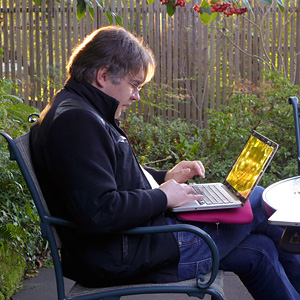 |
Clemens
Par, founder of swissaudec,
presents at tmt27 for the first time a paper about his
ground-breaking and patented new methodology for audio signal
coding.
The paper will be delivered in English on
Saturday, 24 November 2012, Spatial Audio, 18:00 - 19:00, Room R1. |
SA6:  Two
Undiscovered Treasures in Spatial Audio: Inverse Problems and Invariant
Theory Two
Undiscovered Treasures in Spatial Audio: Inverse Problems and Invariant
Theory
Retrieving higher order (i.e. multichannel) signals from a lower number
of input channels is a well-known problem (generally referred to as “upmixing”),
which may be satisfyingly solved with stereo or multichannel content, thus
providing a high level of accuracy regarding localization and sound
envelopment. Such methodology, however, fails when mono input signals should
be processed in real-time – prior art then will not achieve sound source
separation in real-time, particularly with sound sources showing the same
frequency! At the same time any upmixing algorithm implies comb filter
effects when the signal order is to be lowered again (“downmixing”) –
an annoying effect, for instance, with HD television broadcasts generated by
means of prior art upmixing tools, which are subsequently being played back
on a stereo device. This paper presents an entirely new approach by applying
inverse problem theory to the world of audio (to which we subsequently refer
as “inverse coding”). Inverse problems were described first by
Russian-Armenian physicist Viktor Ambartsumian in 1929, then solving, for
instance, complex linear integral equations by a simple numerical solution.
Generally speaking, lossy data of lower order may be recovered to finally
represent a data set of higher order e.g. by means of specific matrix
inversions. Additionally, algebraic invariants (a property of a class of
algebraic objects that remains unchanged when specific transformations are
being applied) may serve as “tags” to speed up signal calibration. The
result is highly efficient and comb-filter-free real-time upmixing of any
given stereo, Surround or 3D audio content for the sake of restoration,
troubleshooting, postproduction, broadcasting and content distribution. In
particular, inverse coding may help the sound engineer to avoid colouration
effects with spot microphones. In audio coding spatial bit rates may be
lowered up to 200 times with multichannel content for the sake of efficient
transmission over existing studio networks - and (the good news for 3D audio
content providers!) future low bandwidth transcoding consumer devices will
be able to cope with genuine 3D audio content of highest computational
complexity. Clemens Par (swissaudec GmbH)
See swissaudec below
-
Auro 3D -
Principles in Surround Recordings with Height
This 2011 White
Paper by Theile and Wittek outlines the possible directions for 3D audio
sound, where 3D means direction, distance and height. It reviews the
limitations of 2.0 stereo and 5.1 surround due to phantom source instability
and practical setup implementations. Described are different 3D rendering
systems for playback and microphone setups for recording. This is a very
interesting survey of what we have today and what might be the n-channel
future. I am still amazed of what can be extracted in natural sounding
spatial information from a properly done 2-channel recording. See Watson.
A German version of the paper is available at www.hauptmikrofon.de
and much more.
-
Noise
Shaping Sigma Delta Based Dacs & Digital
Jitter and Volume Controls
Martin
Mallison, Chief Technical Officer of ESS Technology, lucidly presented and
explained the technical issues at RMAF 11.
Watch it on YouTube.
I do not doubt that people can hear Sigma-Delta noise shaping differences or
digital jitter, though I have no personal experience. But I question his
explanations as to why they are audible. Data measured in the frequency
domain were not related back to the signal's nature and its amplitude in the
time domain and vice versa. In general the vertical axis of the measurements
was not discussed. In Fourier analysis the axis is calibrated in sinewave
amplitude, but it is also used to read the amplitude of impulsive signal
spectral components and of noise. Both are broadband signals that often
exceed the bandwidth of the Fourier analyzer. To understand their amplitude
presentation one must know the analyzer's impulse bandwidth and noise
bandwidth. The spectral components of an impulse may be of very low
amplitude, but in the time domain they add to a large, very short duration
pulse with a repetition rate corresponding to the spectral line spacing.
Similarly the amplitude of the same noise in the time domain is a function
of the hearing bandwidth, e.g. 20 kHz. We hear both in the time domain and
the frequency domain so we should also analyze physical processes in both
domains. The audibility on the Rebecca Pidgeon track apparently is due to
the impulsive signals from metal beads.
Jitter is different. Jitter causes non-linear distortion, i.e.
intermodulation of broadband signals. I doubt that this is what we hear
because of its low amplitude. But jitter has a spectral distribution, which
should have been shown in addition to its PDF. I believe that it is the very
low frequency spectral content of the jitter, which typically has the
highest amplitude, that accounts for audibility as phase modulation of the
audio signal in the time domain. Again proper amplitude calibration of the
analyzer is important to arrive at a meaningful interpretation of the
numbers.
-
Subjective
assessment of audio quality - The means and methods within the EBU
The European Broadcasting Union defines In section 3.2 of
this EBU-Technical Review article from 1997 a set of
subjective parameters, which cover the technical quality of “acoustic
music”. This set should be very useful for recording engineers in
assessing their work. The demonstration CD PEQS, described in EBU-TECH 3287
(October 2008), gives 66 examples of different
recording quality. The LX521 Monitors
readily show the differences. EBU-Tech
CD files.
-
Less and
More: The Design Ethos of Dieter Rams
I have admired the exterior design of Braun products under Dieter Rams'
leadership. The SFMOMA has currently (January 2012) an exhibition of his
work and also of his influence upon other designers (e.g. Steve Jobs &
team). Follow the link below to his 10 Design Principles as shown on a
poster in the museum bookstore and along the walls of the exhibition.
Interview
with Dieter Rams (2017)
-
Testing
One, Two, Three
Stuart Yaniger describes the methodologies and pitfalls
of listening tests in Volume 2 of Linear Audio, p.161-174.
Myself and others, notably Don Barringer, have done a lot of listening tests
to fine-tune the ASP response of the ORION, which was derived from
free-field acoustic measurements. This is clearly a subjective process
because what I and others hear is not merely a function of the sound
pressure streams at our ears, but also of our expectations and the sonic
attributes we pay particular attention to. We may come to agreements, if we
have the same reference sounds in our minds, but this does not necessarily
guarantee that we have developed a neutral transducer. Stereo is
particularly tricky because we create a phantom sound scene that only exists
in our minds. It is a good magician's trick, if we can hide the loudspeakers
and the listening room in the process. And when have we reached YOUR
perceptual noise level, where you are no longer sure that this way or that
way is more accurate? I only know when I have reached MY perceptual noise
level, but it is not fixed in time and can change with new expectation and
attention. Do I then start over? In the end could I fool a child or dog?
-
MP3 and AAC explained
Karlheinz Brandenburg
of Fraunhofer Institute and MP3 fame explains the perceptual coding and
decoding of sound in this 17th AES International Conference paper from 1999.
Though audiophiles often malign these compressed and lossy data formats I
have found that many of today's Internet Radio broadcast stations have very
satisfying sound quality and provide interesting classical music and culture
programming. I use a Squeezebox as signal source and an iPod to control it
remotely.
-
High Res
Music
What looks like a complete list of suppliers of high-resolution music files
can be found on the auraliti website.
-
2L - the Nordic Sound
"Norway is blessed with many churches and cathedrals and most of 2L's
recordings are made in these wonderful spaces. The music captured by 2L
features Norwegian composers and performers, and an international repertoire
reflected in the Nordic atmosphere."
Check out www.2l.no for
downloads of high-resolution sound files.
-
HDtracks.com
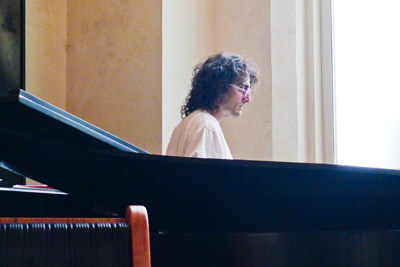
David Chesky - Composer, musician, producer,
visionary |
"Founded by David and Norman
Chesky of the audiophile-record label Chesky Records, HDtracks
is a high-quality music download service offering a diverse catalog of
independent music from around the world. HDtracks does not believe in
DRM, and as a result, we offer a selection of unencrypted files that
play on any computer or portable device.
We have several formats available for fans of all
types of music. If you would like genuine CD-quality sound, HDtracks
offers both AIFF and FLAC lossless files. For those who wish to carry
their music in a portable player, we have 320kbps files that far
exceed the quality of standard MP3 files.
Finally, audiophiles take note. HDtracks offers select titles in
ultra-high resolution 96khz/24bit files. This is true DVD-audio sound
quality for music lovers that demand the very best!" |
-
Listen - LIFE WITH CLASSICAL MUSIC
"North America’s classical music magazine covering people, places and
events; recommendations of recordings, books, and film; and all the many
ways our lives are touched by classical music. Published by ArkivMusic,
the Source for Classical Music."
-
Introduction to 3-D Audio
Fundamental aspects of spatial hearing in humans are studied by Edgar Choueiri in the 3-D Audio and Applied Acoustics
Laboratory at Princeton University. One of the projects deals with optimal cross-talk cancellation of loudspeaker stereo
signals at the listener's ears. The process works optimally in a room
without reflections (anechoic) and for binaurally recorded material.
Coincident and near-coincident 2-microphone recordings benefit also.
Coherent spatial information is usually lost in mixed-down multi-microphone
recording and cannot be recovered by cross-talk cancellation. I guess that playback
in reverberant spaces is optimized when using loudspeakers with frequency
independent radiation patterns such as omni, cardioid and dipole, together
with a symmetrical placement of the loudspeakers relative to large
reflecting surfaces and at least 1m away from them. This would be the same
setup as for traditional stereo playback in acoustically small spaces.
-
Listening
in on the listening brain
A report about research into the auditory brainstem response to complex stimuli (cABR) in
the June 2011 issue of Physics Today. Hearing involves a bi-directional
stream of information - from inner ear to brain and from brain to inner ear.
Note that the brainstem response to a 0.1 ms impulse shows activity for about
7 ms. Listen to three examples of naturally produced sounds contrasted with
their brainstem responses
at the end of the report.
-
KHANACADEMY
While not much about audio www,khanacademy.org surely has something to teach or to
catch up upon for everyone. See for example his 10 minute talks about Specular and Diffuse Reflections or about Wealth Destruction.
-
The Well-Tempered Computer
Vincent Kars' introduction to computer audio provides a wealth of
information and links to suppliers for setting up a playback system where
your music collection resides in computer memory. Seeing the different
acronyms and terms explained and compared is very helpful. For many
audiophiles it is like learning a new language.
See also the dCS
Guide to Computer Audio for assembling a playback system.
-
Dipole Bass
vs Monopole Bass
Elias Pekonen measured and compared the response from a dipole bass
loudspeaker to that of a monopole (box) loudspeaker in an acoustically small
room using constant Q periodic wavelets. He observed that the dipole source
better preserves the modulation envelope as shown very clearly in the
frequency-time-amplitude data presentations on his website.
The work confirms my own conclusions from shaped tone-burst tests (Publications #21) and those of Holland,
Newell, Mapp in "Modulation Depth as a Measure of Loudspeaker Low Frequency
Performance", Proceedings of the Institute of Acoustics, Vol.26, Pt.8,
2004.
With the Toneburst CD you can hear
changes in bass envelope modulation for different locations in your
listening room.
You can also sift through the questions, opinions, misunderstandings,
irrelevancies, insights and selfassertions of the related diyaudio.com forum discussion.
I hope that the time response in the discrete mode frequency range of a room
will eventually get as much attention as the steady-state frequency
response. Bass sound perception is derived from both.
-
Linear
Audio - Volume 1
The second issue of the semi-annual bookzine has just been published and is
available from www.linearaudio.net.
It continues the collection of thought provoking and practical articles
written by experts in various branches of audio. For example, I found the
article on "Low-noise microphone preamp design" and "The
F-word - or, why there is no such thing as too much feedback"
particularly interesting. Check out the content. What is published here is
too practical for the scientific paper ambitions of the JAES and far outside
the range of Stereophile and TAS. Decades ago Wireless World was the place
for this kind of audio engineering thought, but not that magazine's main
topic.
-
Vector Wavefront
Format (VWF)
Graeme Huon from HUONLABS
in Australia presents a sound reproduction system that conveys not only
direction but also distance of acoustic sources. It is based on the premise
that we hear the curvature of the arriving wavefront. I am not convinced,
but here is a series of short articles that explain the concept. Also shown
is a loudspeaker design with omni polar response obtained from controlled
diffraction plate (CDP) structures, which are claimed to accurately combine
the outputs from multiple drivers on a spherical surface.
See also: Graeme Huon and Zeljko Velican, 'Spatially
consistent reproduction of the reverberant sound field', 116th AES Convention,
Berlin, 2004, Preprint 6109
Graeme Huon and Zeljko Velican, 'Low frequency optimization and
non-bass masking effects for sound field re-creation', 115th AES Convention,
New York, 2003, Preprint 5989
-
The Inaudible Loudspeaker - Unmasking
audio sound information by applying monaural stereophonics
Leo de Klerk, a Netherlands artist and recording engineer, proposes a vertical array of 4 loudspeakers, (Lbottom +
Ltop) & (Rbottom + Rtop), to produce a center phantom scene from a stereo recording that will
not shift for off-axis listening angles. The loudspeakers should be omni-directional. Bottom and top loudspeakers
receive the same input signal. I have not heard such configuration. An
excited listener to my Pluto 2.1 demo at the TMT26 was trying to get Leo de
Klerk to come and meet me, but our schedules prevented it from
happening.
Omniwave
loudspeakers.
-
Orion
Gateway
Eric Weitzman started a new
website and blog describing his Orion experience and modification, his
Hubble Super Regulator, Balrog Turntable, and Curcio Phono Preamp to which
you can leave replies.
-
Open
Baffle Dipoles - How they work and how to use them well
Rudolf Finke has on his website DIPOLE+ an article "Open baffle 1.pdf" that
shows calculated
on-axis and off-axis frequency responses of drivers on differently
shaped baffles. In particular much attention has been paid to the transition
region from 'dipole' response to 'dipolar' (beaming) behavior of practical
size drivers. It is a well done study of trends and limitations.
-
RCA Victor presents 'Sound and
the Story' (1956)
Here is a historic video that clearly states RCA's sonic goals for
their recordings in the days of mono and early stereo:
At 02:35:
“A planned illusion … the best seat in the concert hall”
At 23:10: “ It’s traveled a long way – for an
illusion. The last stop home, and the best seat in the concert hall.”
No wonder the Living Stereo series got such legendary reputation. Check out
the placement of the listeners and especially of the monitor speakers in the
recording studio, well away from all walls (for example at 06:10 to 06:50).
The entire room, which features dimensions larger than the typical studio of
today, resembles acoustics more characteristic of a large living room than
an over-damped studio (but often with lots of very early reflection from the
huge mixer console in front of the typically flush mounted wall speakers).
RCA placed the main microphones above and in front of the orchestra. What
were the problems with recording directly from "the best seat"?
Could such recording be done with modern microphones like a pair of Schoeps SuperCMIT
and capture the timbre, localization and spaciousness as heard from
"the best seat"? What is the recording engineer's goal today?
- Mikrofonaufnahmetechnik und Tonstudiotechnik (Recording
& Studio Techniques)
Eberhard Sengpiel was honored in 2010 by the Verband Deutscher Tonmeister (VDT) for his contibutions
to the Tonmeister (~recording engineer) profession. His website contains a very extensive
compendium of lecture notes (example)
for recording engineers. But I found nothing about issues or solutions to stereo playback in reflective spaces, which the vast
majority of consumers have to deal with. Why are
there no lectures about the all-important "Wiedergabetechnik"
(Playback Techniques)? Why no discussion of the influence of the "Mono
Recording Angle", which captures sound outside of the stereo recording
angle?
- swissaudec
Clemens Par creates
professional three-dimensional sound from one single audio channel. He
thereby saves 50% up to 88% of the audio signal bandwidth and, vice versa,
enhances any audio data to a professional three-dimensional sound image. I
was impressed by his demo at TMT26,
but how could he do
it?
- BBC Research & Development Reports
Many interesting reports
about loudspeaker design and test & evaluation methods from 1957 to 1999
- Some factors
in loudspeaker quality
H. D. Harwood from the BBC Research Department talks in this landmark Wireless World article from 1976
about observations and unresolved issues related to loudspeaker design. On
page 48 he questions the optimum on-axis frequency response and mentions a
shallow dip between 1 kHz and 3 kHz. On page 54 he pleads for a non-uniform
axial frequency response. Experiences with equalizing an initially flat
on-axis response to obtain the realistic sounding ORION-3.2
have convinced me that 'flat' is not correct for a stereo system. Here we must create believable phantom sources from
two real sources at +/-30 degree angle to the listener, at the 'sweet spot',
in the room. Nor is the BBC dip the answer. Instead, the response must be
flat above 100 Hz and then gradually drop to a lower level at high
frequencies. There are general physical and psychoacoustic requirements for
such a response, which I will explain at a later
time. A specific on-axis
frequency response curve is usually the secret behind a good sounding
loudspeaker. The marketing department likes to label this curve
'flat'.
For Stereo, neither the two monitor loudspeakers in the
recording studio, nor the playback loudspeakers in the home, should have a
flat on-axis frequency response. A corresponding power response and
placement of the acoustically small loudspeakers in the room at least 1 m
away from large reflectors, hides both loudspeakers and room acoustically
from the listener in the 'sweet spot'.
- Acoustics Handbook
Application Note 100 from Hewlett Packard Co. marks the company's
short-lived entry into the acoustic measurement field in 1968. The flagship
product was the Zwicker Analyzer for loudness measurements. AN100 contains
fundamental and useful information in its 116 pages (9MB) such as physical
acoustics, physio-psychological acoustics, survey
of measurement methods, instrumentation, calibration of microphones, sound
level meters, filters, frequency analysis, standards.
- Application of linear-phase
digital crossover filters to pair-wise symmetric multi-way loudspeakers
Part 1: Control of off-axis frequency response, PP presentation 1
Part 2: Control of beamwidth and polar shape, PP
presentation 2
Ulrich Horbach and D.B. (Don) Keele, Jr., AES
32nd International Conference, September 2007
Here is a truly ground breaking, sensible and practical
application of DSP to the design of crossover filters and the polar response
of large multi-way active loudspeakers. Very exciting work! It avoids lobing
of the
vertical polar pattern.
The Audio Toolbox by Dr. Ulrich Brüggemann (((acourate))) now
includes these crossover filters.
Putting the
Science back into Loudspeakers
John Watkinson from Celtic Audio Ltd. presents his observations and theories
in a thought-provoking paper. I see many parallels to my
work, in particular his emphasis on minimal diffraction, i.e.
omni-directional radiation and the consistency of the reflected with the
direct sound spectrum. He emphasizes the necessity for linear phase response
and waveform fidelity for localization and spatial accuracy of phantom
sources. I have not found or heard convincing evidence for this, if phase/
group delay distortion is kept low. Linear phase can only matter for
instantaneously broadband transient signals. The highpass nature of
loudspeakers, though, requires 12 dB/oct low frequency response for minimum
group delay build-up, not vented enclosures. The Cabar
stereo monitor loudspeaker system bears many similarities to a pair of Pluto 2.1. I designed Pluto because I wanted
to compare a low diffraction, acoustically small source to Orion, which led
to the rear tweeter addition in Orion+.

- Constant
beam-width transducer (CBT)
D. B. (Don) Keele has done extensive work on line
array loudspeakers for sound reinforcement applications, where it is
important to control the vertical radiation pattern and to avoid lobes,
while maintaining wide horizontal dispersion to cover an audience. In a
curved array with proper shading the delay of individual drivers is obtained
mechanically and the output level from groups of drivers in the array is changed
independent of frequency and only according to their placement in the array. The
joint paper with Douglas J. Button describes straight and
curved arrays and compares their vertical radiation pattern to that of a
2-way loudspeaker over a ground plane. The paper is rich in graphical
illustrations.
An introduction to the CBT and its application is given in Don's Boston
AES-ASA-BAS presentation from January 2010 with overheads and accompanying audio/video (Don
Keele.mov).
I have heard Monte Kay's center speaker CBT and was quite impressed with its
acoustic performance in his home theater application. It seems the CBT in
its various forms presents a business opportunity for highest quality sound
reinforcement, where especially the mid and high frequency portions of the
spectrum must be properly dealt with. It would be the end of the
horn and compression driver in quality critical applications.
- Microphones and
acoustic measurements
The Bruel
& Kjaer Library has a collection of their Application Notes,
Technical Reviews, Primers, Handbooks, Conference Papers and a Dictionary.
It is a treasure chest of information about acoustic and vibration
measurement methods and tools. I desired but could not justify a product
purchase from B&K, but I was an avid collector of their publications.
Here now is everything in one place and conveniently accessible.
- The
Physics and Psycho-Acoustics of Surround Recording (2005)
David Griesinger
places emphasis on the streaming behavior of sound as he explains perception
of direct and reflected sounds in a surround
recording context. Intelligibility,
reverberance, distance, and mud are his major concerns. Unlike for Theile
and Wittek below, the placement of phantom sources in a coherent spatial
continuum is of less concern. He states, though, that "Recordings stand
or fall on their ability to satisfy the needs of human hearing. This is
constant among people, even among recording engineers." He may not be
aware how much is revealed about the recording technique when a loudspeaker system
like the Orion is used to evaluate the plausibility of the auditory scene
that is heard.
- Multichannel
Natural Music Recording based on Psychoacoustic Principles (2001)
Guenther
Theile discusses techniques
for recording music when natural reproduction over 3 front loudspeakers
and 2 surround loudspeakers is desired. The perceptual effects that are
generated by 5-real and n-phantom sources depend upon the microphone
configurations used. Curiously, the potential influence of loudspeaker
radiation pattern and room reflections upon spatial sound reproduction is
not considered. Wittek below, makes the same
omission.
- Perceptual
differences between wavefield synthesis and stereophony
Chapter 3 of the above PhD
Thesis from Helmut
Wittek contains a wealth of information about the properties of stereo,
about phantom sources and perception models. Chapter 2 is an introduction to
the perceptual attributes that apply. Dr. Helmut Wittek is the Managing
Director of Engineering for Schoeps
Mikrofone in Germany.
- A Case for
Subjectivity
Jens
Blauert discusses perception, reality and virtual reality in
this paper from the 2nd International VDT
Symposium on 'sounddesign', 2007, in Germany. The paper is also
interesting in relation to my proposed tests for the accuracy
of a stereo system by concentrating on the plausibility of the reproduced Auditory Scene and
the abstraction level of the character of the reference that is implied in
such tests.
- The
Seductive (Yet Destructive) Appeal of Loud Music
Even though it is well known
that prolonged exposure to loud sounds produces hearing damage, it is very
common that people listen at dangerously high volume levels. Barry
Blesser attempts to explain the phenomenon in
this article.
- Audio Musings
by Sean Olive
An informative blog
about loudspeaker evaluation and test methods at Harman International (JBL,
Infinity, Revel). Sean is the Director of Acoustic Research.
- Enjoy the Music - Review
Magazine
A timely overview of what is happening in the audiophile world. Some
interesting articles from BAS
Speaker and other magazines. It could be worthwhile to be on the mailing
list.
- A sensibly
designed loudspeaker
On the exhibit floor of the 129th AES Convention in Munich I saw a
loudspeaker that impressed me by the logic with which it was designed, the GRIMM
AUDIO LS1. I could not listen to it closely because the surrounding
noise level was far too high, but what I saw and heard from the exhibitors
convinced me that the LS1 is a remarkable loudspeaker design. The wide
baffle yields a forward pointing and smooth polar response over a very wide
frequency range with a low frequency transition region to omni-directional
behavior. The inside of the box and the panels appeared to be properly
designed. The speaker is active and uses intelligently applied DSP for
response correction. A subwoofer can be correctly integrated if needed. One
can only hope that the LS1
breaks bad habits in recording studio and home.
- The
"Stereo Dipole"
A very closely
spaced loudspeaker pair with head related cross-talk cancellation that
produces a virtual acoustic environment. This and other interesting work
from the Institute of Sound and Vibration Research at the University of
Southampton, UK.
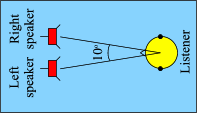
- Monte Kay's Home
Theater
An enormous
construction project that has been in the works for a number of years. I
am already certain that when finished it will have outstanding sound
performance.
- SOUND REPRODUCTION
- Loudspeakers and Rooms
Floyd E. Toole, Focal Press, 2008
In this book Floyd Toole summarizes and explains conclusions from a lifelong
involvement with audio. I highly recommend it to anyone interested in
factual information about loudspeakers and listening rooms, about
measurements, listening observations and their practical implications. It is
lucidly written in easy to understand language, extensively illustrated and
referenced. It deals with the reproduction of sound - which existed in a
space - inside another space. My only regret is that the potential of
2-channel playback in doing so has not been fully explored and
misrepresented. This is
understandable because the conventional box loudspeaker with its frequency
dependent directivity index has been used for almost all of the observations
that are discussed. In fact, the particular interaction of a box loudspeaker
with the listening room makes it more difficult for our ear/brain perceptual
apparatus to hear the recording venue's space and acoustics, provided that
such information has been captured in the recording process. Floyd focuses
on multiple loudspeaker surround sound. He considers this approach to
spatial sound reproduction as much more rewarding and he provides extensive
practical information for that. The book is very comprehensive and in my
opinion a "must-read" for loudspeaker designers, recording and
mastering engineers, room-acoustic consultants, audio reviewers and
audiophiles. The book is about theory and praxis. It debunks much of the BS
that seems to have permeated the audio industry and many of its customers.
www.amazon.com
- The first open
baffle loudspeaker?
Chester W. Rice and Edward W. Kellogg: Notes on the Development of a
New Type of Hornless Loudspeaker,
Transactions of the American Institute of Electrical Engineers, issue 44,
1925, pages 461-475.
From page.464: "Provision was made for boxing in the
instrument, and an interesting experience in this connection was that
of placing the box over the back, which had the same general effect on sound
quality as applying a short horn
to the front of the diaphragm. Both helped to bring out the low tones and
gave rise to some resonant effects.
Bringing out the low tones was due principally to preventing circulation of
air between the front and back of the diaphragm.
The resonance was in the horn in one case, and in the box in the other.
A peculiarity of devices employing very flexibly supported diaphragms is
that resonant air chambers behind the diaphragm
do about as much harm as resonant cavities in front of the diaphragm, the
diaphragm usually taking part in the resonance.
Attempts to damp the interior of the box with felt were not entirely
successful.
A happy solution of the problem of preventing circulation was obtained by
employing a flat baffle-board,
at the suggestion of Rice, who was the first of the group to recognize the
importance of the circulation factor
in preventing the radiation of low tones. With the flat baffle, no air
resonance occurs and both sides of the diaphragm
give useful radiation, the total power radiated for a given diaphragm
amplitude being nearly four times as great
as that radiated when the back of the diaphragm is enclosed."
This is probably the first description of an open baffle loudspeaker.
The laboratory model is shown on page 474 and is described as:
".... cabinet set containing rectifier, amplifier and
loud speaker. The front of the cabinet acts as a baffle.
To prevent air resonance in the box, the sides and back are vented by
inserting panels of perforated brass."
The first active loudspeaker as well?
(Source: Ralf Gerhard Ehlert, Musikwissenschaftliches Institut der
Universitaet Koeln, Medienstimmen)
- H-frame loudspeaker
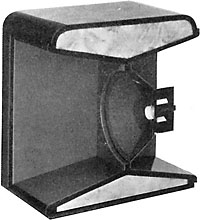 |
Lenzola-Doppelstrahler
»Janus«
"Resonanzfrei durch
dicke mit Mineralwolle isolierte Doppelwände.
Die Leitflächen vor und hinter der Membran vermeiden akustischen
Kurzschluß
und ergeben eine günstigere Schallabstrahlung" Abb. 61 aus [Günther
(Hg.) 1936]
Dipole
PA loudspeakers from Telefunken at the 1936 Olympics.
Lautsprecher
auf der Berliner Funkausstellung 1939
"Die Entwicklung des
dynamischen Lautsprechers scheint schon seit mehreren Jahren so
ziemlich zum Abschluß gekommen zu sein. Man sieht deshalb wenig Neues.
Nach den Angaben der Aussteller bemüht man sich zur Zeit vor allem
darum, die Feldstärke im Luftspalt zu erhöhen, um die
Empfindlichkeit zu steigern und um, was erheblich wichtiger erscheint,
die Haupteigenschwingungen der Membranen zu dämpfen. ...."
From a German website that has collected
historical information on loudspeakers, amplifiers and
microphones. https://www.medienstimmen.de/ela/lautsprecher/modelle/main.htm |
- This Is Your
Brain on Music - The Science of a Human Obsession
Dan Levitin was the Keynote Speaker at the 123rd AES Convention in New York,
2007. He gave a fascinating talk on why we can get goose bumps when we
listen to music. What is the true impact of powerful music on the human
brain? As a former rock musician, producer and now professor at McGill
University Laboratory for Musical Perception, Cognition and Expertise in
Canada, he combines art and science in this most
stimulating and easy to read book. (Dutton, 2006)
- Spaces Speak, Are You
Listening? - Experiencing aural architecture
A book about the science, art and culture of acoustic
spaces written by Barry
Blesser and Linda-Ruth Salter. In light of my observations with the ORION+,
for attempting to reproduce one acoustic space inside another one, chapters
such as "2 - Auditory Spatial Awareness", "6 - Scientific
Perspectives on Spatial Acoustics" and "8 - Auditory Spatial
Awareness as Evolutionary Artifact" are of particular interest. (MIT
Press, 2007)
- Multidimensional
Audio
A paper about audio
measurements by Henning Moller of test instrument maker Bruel &
Kjaer. The information is technically sound, but the measurement
applications are dated. The paper is very educational, particularly for
those in the DIY community who lack measurement capability, especially for
free-field acoustic measurements, and instead rely on computer simulation
and their ears. That is a very limiting method for designing loudspeakers
and guarantees sub-optimal results if the goal is accurate sound
reproduction.
- Loudspeaker
Placement for Optimized Phantom Source Reproduction
| A joint paper by J.
Gerhard, B. Theiss, M. O. Hawksford from the 1996 AES Convention in
Copenhagen (Preprint 4246).
Their loudspeaker layout is quite different from
the ORION++, but similarly based on
psychoacoustic observations. I suspect that their listening experience
could have been even more convincing, if omni-directional loudspeakers
had been used. Those would have increased the reflected energy from
the wall in front of the listener over the energy coming from the side
walls. That would have reduced the need for micro placement of
speakers and listener to 0.5" (12 mm) accuracy without affecting
imaging precision.
A setup of loudspeakers parallel to the long
wall of the room and close to the listener would seem to be well
suited for small rooms and the PLUTO.
It could also easily fulfill the minimum distance requirement of 3' (6
ms) from any wall. Close listening distance to the speakers also
reduces the magnitude of floor and ceiling reflections if that should
matter.
For general background see: Jens Blauert,
Spatial Hearing - The Psychophysics of Human Sound Localization, MIT
Press, 1996 |
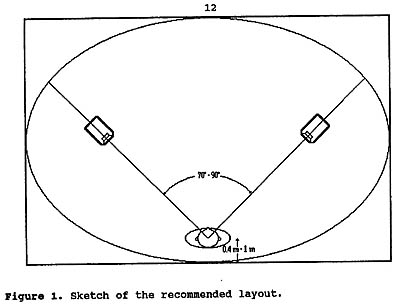 |
- Bob Pease is a legend in
electronic design. In the Pease Porridge column of Electronic
Design magazine he often talks about audio related electronics. For
example, "What's
all this best stuff, anyhow?" shows an easy way to measure
operational amplifier distortion and noise by analyzing the amplified error
voltage. In "What's
all this Sallen-Key stuff, anyhow?" he points to the influence of
the frequency dependent output impedance on filter roll-off performance. Bob
highlights many design issues and deepens understanding of circuit and
component behavior.
- The Acoustics and Psychoacoustics of Loudspeakers
in Small Rooms
Floyd Toole presented a tutorial on this subject at the New York AES
Convention in 2005. Here is a summary as taken from the March/April issue of
Multimedia Manufacturer Magazine. It appears that his latest findings match
more closely my own observations and experiences which had convinced me that
uniformity of directivity over a very broad frequency band, such as from
omni-directional and dipole radiators, is optimal for accurate sound
reproduction in typical living rooms. See also related earlier publications below
and my Letter to the
Editor of TAC.
A comprehensive review of this subject has now been published in the June 2006
issue of the Journal of the Audio Engineering Society by Floyd Toole, "Loudspeakers
and Rooms for Sound Reproduction - A Scientific Review". Highly
recommended study material for what is known and what needs further
investigation.
- Auditory Scene
Analysis
A relatively new field of study which should lead to further
understanding of the listening room's role in audio playback. I highly recommend to take a
close look at the work of Albert S. Bregman, "Auditory Scene Analysis -
The Perceptual Organization of Sound", MIT Press 1990. In a different
application this material has already led to greater audio data compression
rates but with
fewer artifacts. There is an Audio
CD available with 41 demonstrations of Auditory Scene Analysis. The
included booklet gives a very clear introduction to the subject and detailed
descriptions of the demonstrations.
- Quality
in the Age of "Good Enough"
Blair Jackson, MIX
Magazine's senior editor writes about the recording business in the May 2005
issue.
- Loudspeaker
and listener positions for optimal low-frequency spatial reproduction in
listening rooms.
David Griesinger
of Lexicon argues and demonstrates that realistic bass reproduction requires
more than a flat steady-state frequency response in the room. He points out
the importance of the randomly varying pressure gradient between the ears,
the velocity field vector, for spatial envelopment. The now widespread
listening experience with dipole woofers, which set up strong velocity
fields, confirms his observations. See also my Publications
(21), (1) and Issues in speaker design - C.
- Do
You Hear What I Hear?
Learning to listen in a mediated world. An interesting article in the June
2005 issue of MIX
magazine which talks about our auditory references.
- Ripple
Tank (2-D Waves) Applet
Paul Falstad has written and collected many interesting Applets. His Ripple
Tank Applet shows numerous acoustic and electric wave propagation phenomena
in an infinite plane and in a bounded plane. Of particular interest are
visualizations of the wave fields for point and dipole sources when walls
introduce reflections. Note that for acoustic waves the Fixed Edges check
box must stay unchecked at all times. Select a very low source frequency so
that the wavelength is in the order of the wall length to see what happens
in a room at low frequencies. Place the source in different locations. Vary
the distance between the (+) and (-) dipole sources. Focus on a fixed point
in the plane - the listening position - and observe the sound pressure
variation with time relative to that of the source. Check out the 3-D View
and rotate the plane. All this should give you an idea about the complexity
of sound propagation in acoustically small spaces where room
modes dominate. Then increase the Source Frequency and Resolution to
their maximum to see the essentially random reverberant field behavior above
the Schroeder frequency.
- Putting
the Science Back into Loudspeakers - John Watkinson
A thought provoking article about the information capacity of loudspeakers
and how it might be measured. The mp3 encoded tracks on my Demo
CD give you an idea about your own sound system's information capacity
and/or your hearing ability.
The books by John
Watkinson are highly recommended. 'The Art of Sound Reproduction' should
be required reading for every audio equipment reviewer.
- Music
and the Brain - Norman M. Weinberger
The November 2004 issue of the Scientific
American carries an article about what happens in the brains of
listeners and musicians.
-
How
we Localize Sound - W. M. Hartmann
A very readable and thorough review from Physics
Today , November 1999, of how we use our ears and mind to localize sounds.
- Mastering
Audio - The art and the science - Bob Katz
If you are interested in knowing what can be done to the recorded sound
before the bits are committed to a CD, then you should read a few chapters
in this book. It was written by Bob Katz, a well known and respected
mastering engineer. Critical technical content has been checked by Jim
Johnston, formerly of Bell Labs/AT&T. We tend to judge speakers by our
favorite recordings without fully realizing how much the signals may already
have been processed to suit commercial interests. Highly recommended reading
and very educational.
- Decoupling
a midrange driver from the cabinet - Andrew Jones of TAD/Pioneer
Different techniques have been used to reduce the transfer of vibration
energy from a loudspeaker driver to its cabinet. I like to mount the driver
by its magnet and to let the driver basket rim touch the baffle only lightly
so that little force is transmitted. It is effective and easier to implement
reliably than compliant mounting from the rim. The PHOENIX
and ORION Revision 0.1 driver attachments are examples of this.
In a box design I had rested the magnet in a cradle and clamped it with a
metal strap, which could be tightened from the outside using long
screw-bolts.
- Designing
Loudspeakers at Revel - Interview with Kevin Voecks
Note the description of the listening tests. Trained listeners are used, but
what is their reference? Neutral sounding pink noise? Live acoustic sounds?
Speakers are compared against each other in double blind preference tests.
How accurate is the preferred speaker? Note the listening room with
diffusers. Certainly not what most people will use. Kevin Voecks clearly
states the importance of timbre due to direct frequency response, 1st
reflection and power response, the importance of polar response to 60
degrees off-axis horizontally. He points to the listening room as the
biggest problem. The need for multiple woofers to combat modes. These are
areas where an open baffle speaker like the ORION
has clear advantages due to the figure-of-eight polar response down to the
lowest frequency. Thermal compression in drivers and the associated response
changes due interaction with the passive crossover elements are non-issues
in an active speaker. No mention is made of other nonlinear distortion
tests. The importance of reducing resonances (stored energy) is highlighted,
but no mention of how Revel tames the cabinet vibrations or the sound inside
the cabinet. Revel certainly has all the resources one could ever wish for
and their top speakers probably define the performance plateau that can be
reached within the box speaker paradigm.
See also https://www.reed-electronics.com/tmworld/article/CA475937.html
for related speaker design targets of the Harman team.
- Capturing
Music: The Impossible Task - James Boyk talks from a performing musician's view
point about the difficulties
of recording music and reproducing it accurately. (See also James Boyk below)
- The
psychoacoustics of multichannel audio - Robert
Stuart of Meridian Audio Ltd gives a tutorial about the different
psychoacoustic parameters that influence sound perception in single channel
and multichannel sound reproduction. Little of the material is
immediately useful other than to point out the complexity of the processing
that happens between our two ears. It can be expected that multichannel
sound has less masking than mono or stereo, though this depends heavily on
how the different channels were recorded and processed. Given the great
variability of stereo recording, which should be a stable technology by now,
it needs to be seen how well multichannel will do when there are no
standards for recording technique nor playback equipment performance. For
example, neither the SACD or the DVD-A consortium, nor any multichannel
receiver manufacturer, specifies the low frequency roll-off characteristic
of the multiple loudspeakers to be used, which is absolutely necessary to
know for proper bass management. Following merely the installed Home
Theater practices will hardly reveal the full potential of the new sound
recording media. See also my comments
and Publication 19.
- Ambiophonics
- Interesting material on acoustics and psychoacoustics that is well
presented by Ralph Glasgal. This type of reproduction system requires a
dedicated room and is capable of a convincing sonic experience. Yet, it does
not fit my life style and there is something about it that I find tiring
upon extended listening.
- Reference earphones - My
motto is "True to the original",
which means true to what has been placed on the storage medium be it CD, DAT
or whatever. Every electro-acoustic transducer introduces distortion, with
loudspeakers being the worst offenders. Etymotic
Research ER-4S earphones come the closest to reproducing what was
recorded and they can serve the very useful purpose of identifying the areas
where a given loudspeaker is failing. The accuracy of these earphones can be
significantly improved by inserting a simple passive equalization
network into the electrical signal path. It is very
illustrative, but possibly disconcerting to hear, how a loudspeaker is distorting in frequency, time or
dynamics. For example, take track 2 of Deedee Bridgewater's Live
at Yoshi's CD and listen to the range of her voice, the drum set, the
background sounds, etc. If you are not using dipole bass speakers you will
be surprised to notice the sound that your boxes and room contribute to what
you hear. The earphones can be a reliable reference for comparing frequency
response, transient response and dynamics. I have some trouble with unnatural in-head localization, the lack of any tactile
sensation of sound, and pushing a plug into my ear canal, but at 10%
of the cost of the ORION they are a
most worthwhile investment in accurate sound reproduction.
- MP3 interview
with John Sunier for Audiophile
Audition.
Hear me talk about some of the loudspeaker features that are most important
for realistic sound reproduction.
- Audio
Artistry - The company builds a line of open baffle, dipole loudspeakers that I
designed.
The Beethoven-Elite and Beethoven-Grand are 4-way active systems that
incorporate my latest thinking in speaker design. The two models evolved
from the bi-amplified Beethoven. A review of the Beethoven is available in
the Stereophile
Archives.
The beginnings of the Dvorak series are described in my 1992 AES paper about a
compact dipole design.
The Vivaldi is a 3-way system and demonstrates the high level of performance
that can be obtained even in a fully passive dipole design. The frequency
dependent cancellation of front and rear radiation is a good challenge when
designing for a flat on-axis and off-axis response down to the bass region.
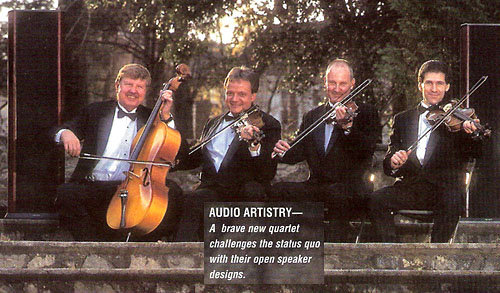 |
Audio Artistry Team
Siegfried Linkwitz, R&D
Marshall Kay, AA President,
Operations, Marketing, Finance, Purchasing, Personnel
Tom Hoffman, Distribution, Sales
Kurt Pasquale, Manufacturing
Vivaldi Loudspeaker introduction, 1996 |
- Shannon Dickson
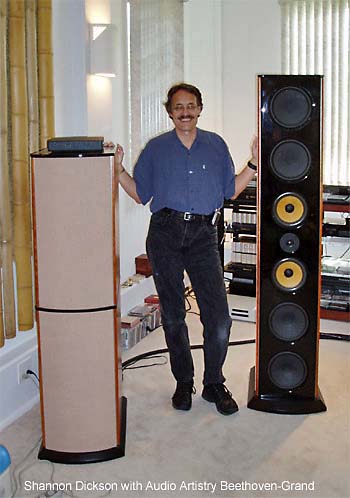
|
Shannon Dickson interviewed me for Stereophile
Magazine, (Vol.19, No. 4, 1996). I give a little history of how I got involved in
audio and what I am trying to accomplish. His article is reprinted
on the Audio Artistry web site.
Here he is in his home in Hawaii with his Audio
Artistry Beethoven-Grand. |
-
Gradient
- Here are loudspeakers developed by Jorma Salmi. His observations and thinking
about the room-speaker interaction are very parallel to mine.
- KLIPPEL
- Measurement and modeling of large signal parameters of drivers and
simulation of their effect upon distortion. Highly educational material that
applies especially to drivers for use in open baffle woofer designs, which
require large volume displacements. See, for example, Wolfgang Klippel's
109th AES Convention paper [58], "Diagnosis and Remedy of
Nonlinearities in Electrodynamical Transducers".
- "Rules of the
Game" by James Boyk - Lecturer
in Music in Electrical Engineering, California Institute of Technology.
Is Digital Audio perfect? This article is an excellent look at human perception
when trying to evaluate new versus old technology.
"....Then we must judge the New, not against the Old, but against the ultimate purpose of both. In audio, this means either a bypass test with a high-quality direct feed identified to the listener, or, if possible, a comparison with the live
sound...."
"The Music
of Sound" is about differences in listening and a reminder that a
loudspeaker must be able to reproduce the most subtle sonic details in order
to convey music's emotional message.
- David
Griesinger's work on sound envelopment is required
reading for anyone interested in a music surround system. The popular home
theater setups for movie viewing provide mostly pan-potted five channel mono
sound, which works effectively because of the dominant cues from the picture
screen. Music surround requires different recording techniques and playback
processing to create a convincing illusion of spatial relationships. For an
introduction to the issues involved study the preprint
of Griesinger's talk at the Nov. 2000 Surround Conference in Paris.
Also, study the insightful MS PowerPoint slide presentation,
"Perception of mid frequency and high frequency intermodulation in
loudspeakers, and its relationship to high-definition audio - A
physicist meets the twilight zone". In addition to the ultrasound
findings, I was particularly interested
in his discussion of distortion in loudspeaker reproduction of massed chorus
and orchestra, beginning with slide 39. These are the two types of signals
that I find most critical for assessing speaker performance. They involve
naturally occurring distortion in the ear, which is also present at a live
performance.
- Are
You On The Road To ... Audio Hell? The problem of reviewing and
comparing audio components in the absence of a reliable reference is
discussed in this article from Enjoy
The Music.com.
I maintain that an accurate system will give you sonic surprises. Too many
systems, though, impart a sameness to everything played through them and the
sound experience becomes predictable.
- Acoustics
Animations - Here are nice illustrations of the sound fields radiated by
monopole and dipole sources.
- Open
baffle, full-range circular array source - A box-less speaker construction for
those with extra room for the rear radiation. I have no doubt that this
approach has the potential for very accurate sound reproduction. Look
at the many pictures if you do not understand Swedish.
- Subwoofers:
Optimum number and location - Based on the assumption that a smooth
steady-state frequency response in the room is most desirable this
investigation by Todd Welti from Harman
International develops practical monopole subwoofer layouts. In my
experience the steady-state frequency response does not explain the qualitative
difference in bass reproduction between monopole and dipole woofers. The
low frequency transient behavior due to the active number of modal
resonances in the room response must not be ignored.
Additionally, the white paper "Getting
the bass right" by Floyd E. Toole will give insight into practical
ways for dealing with the steady-state response of the room.
|